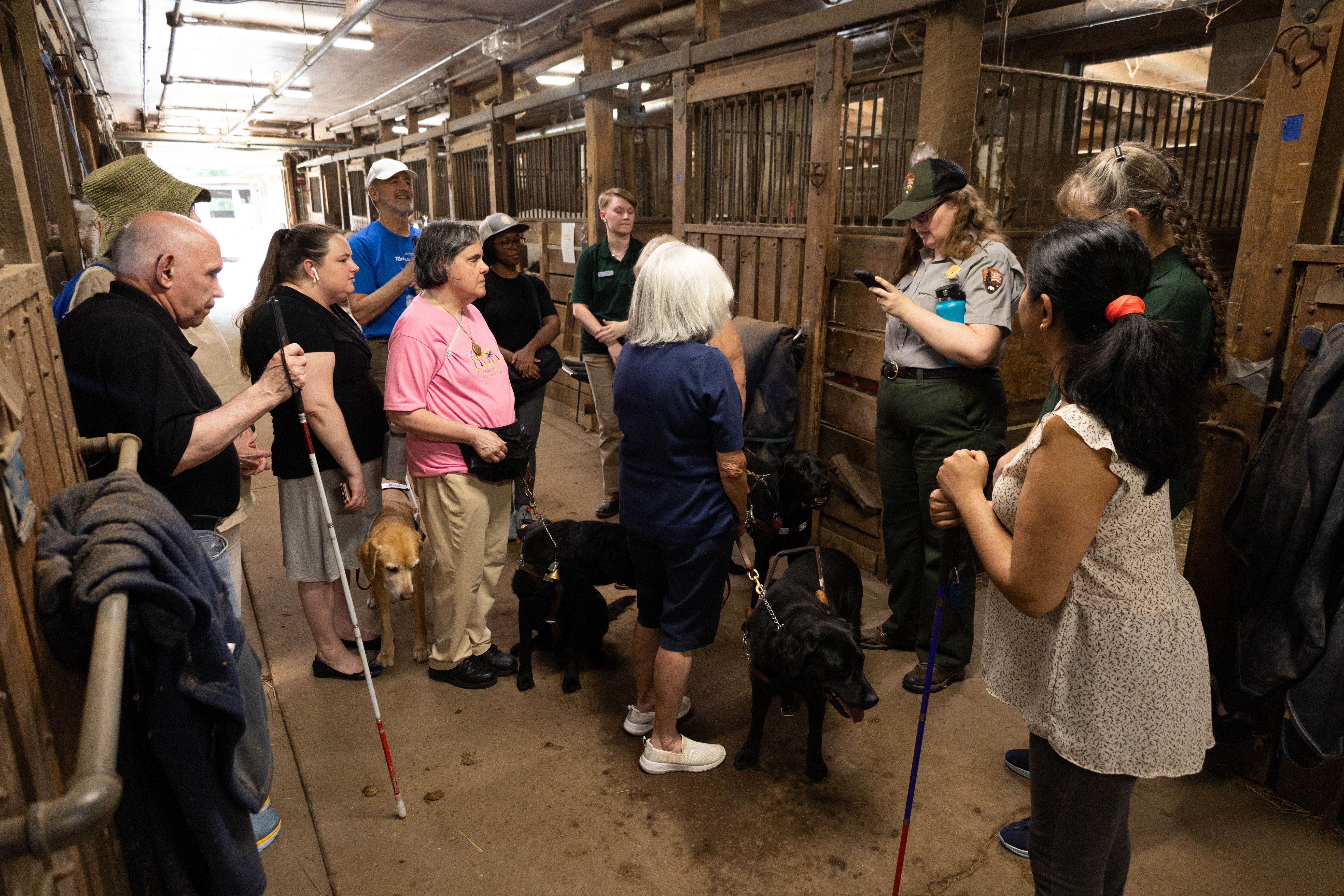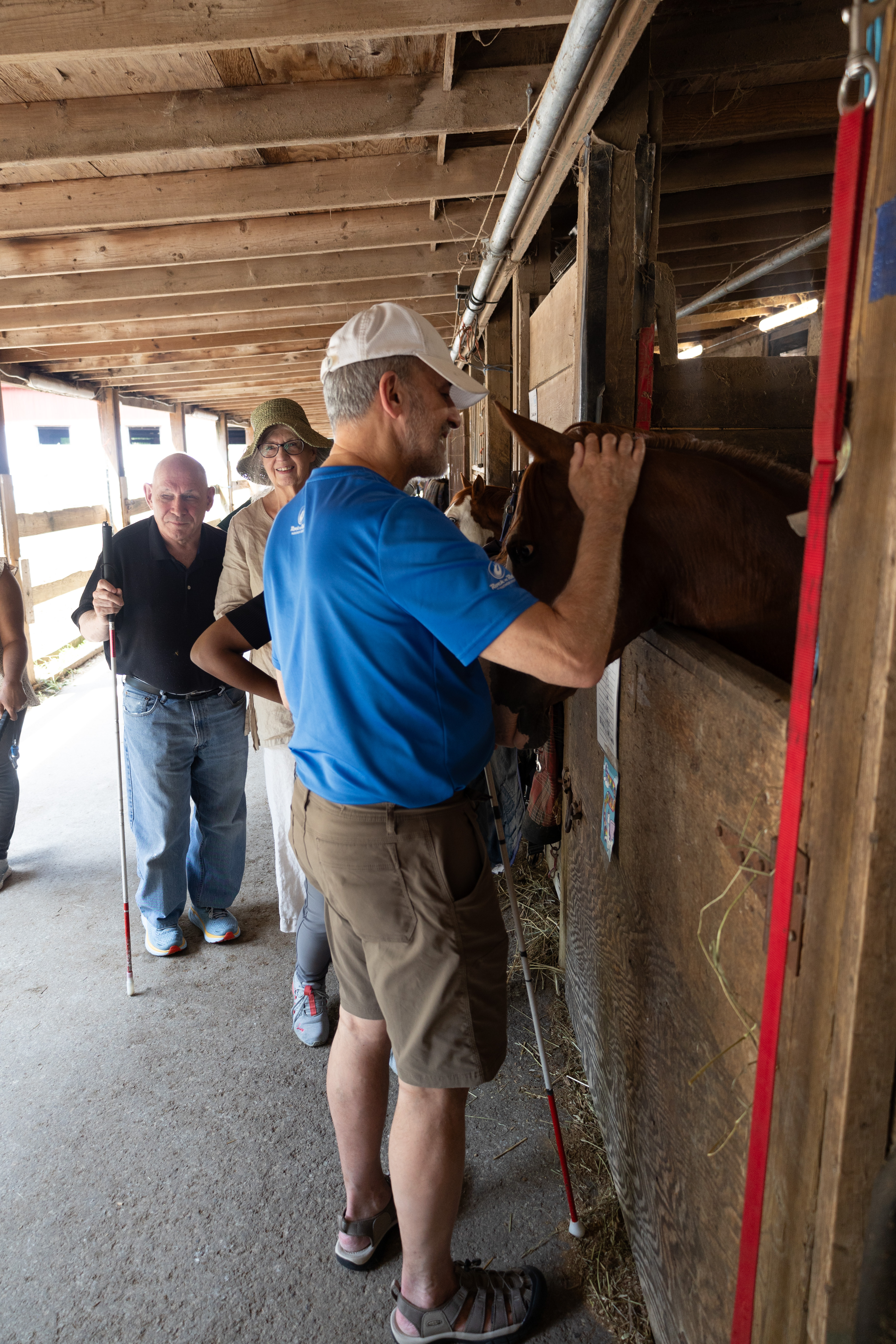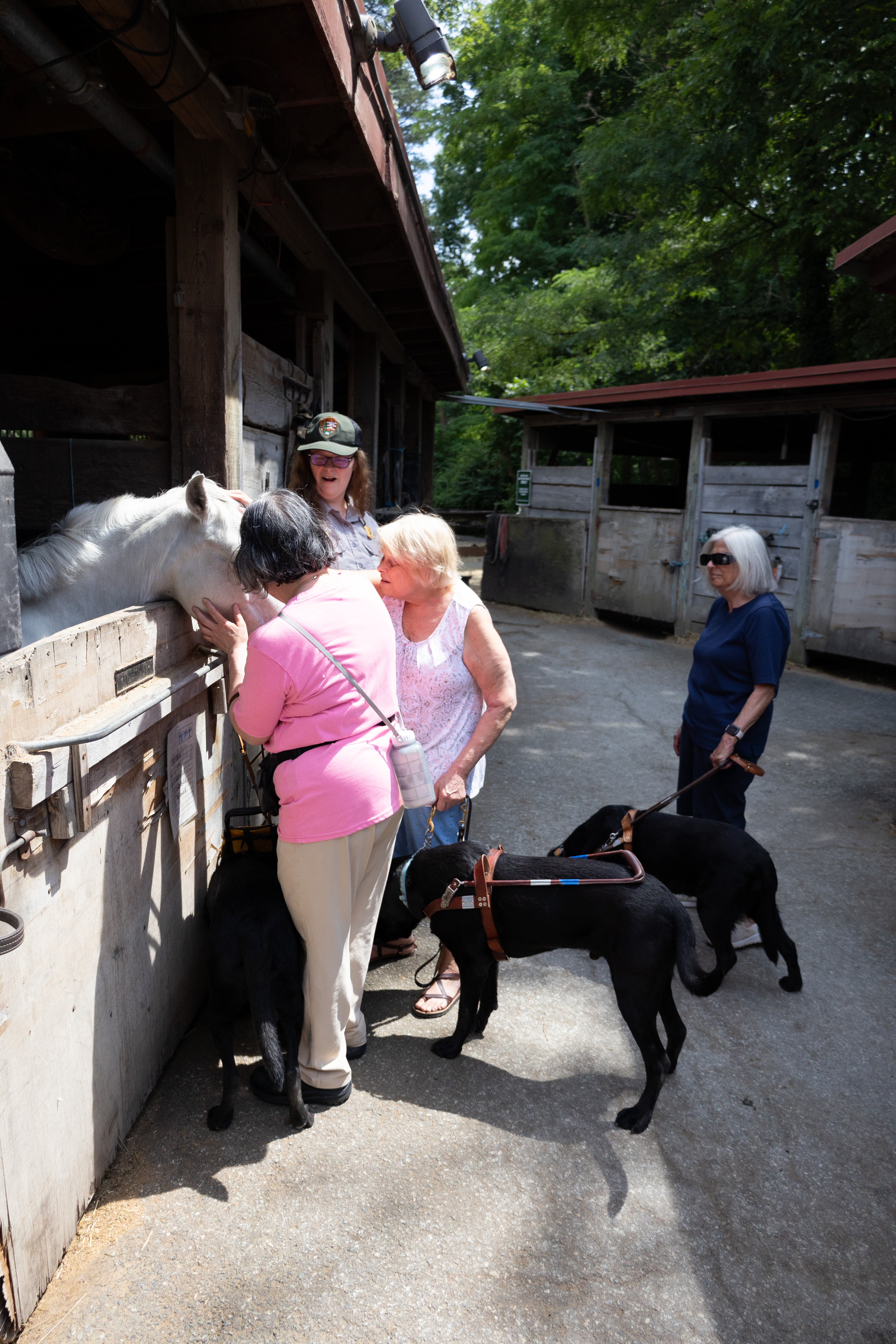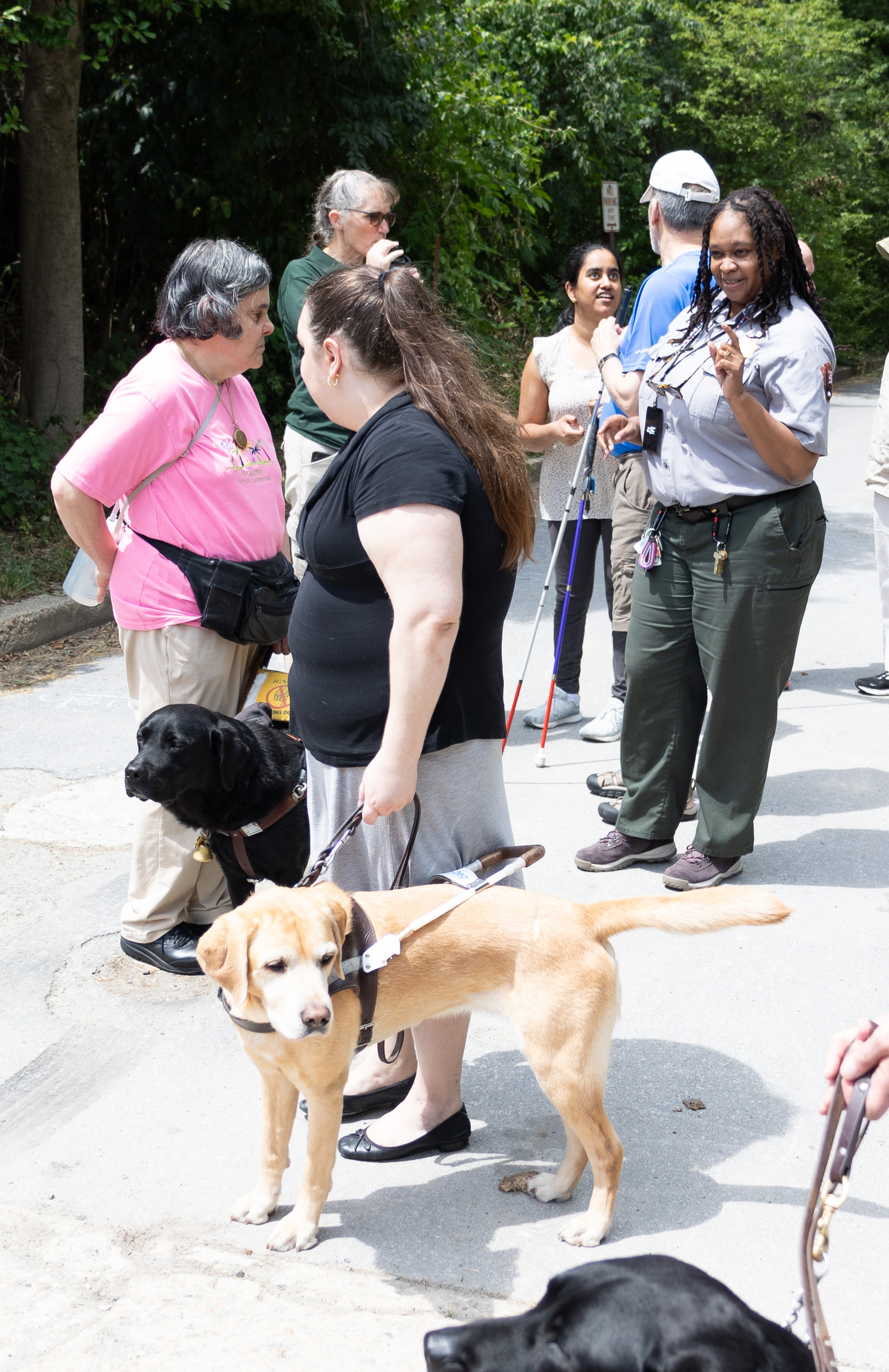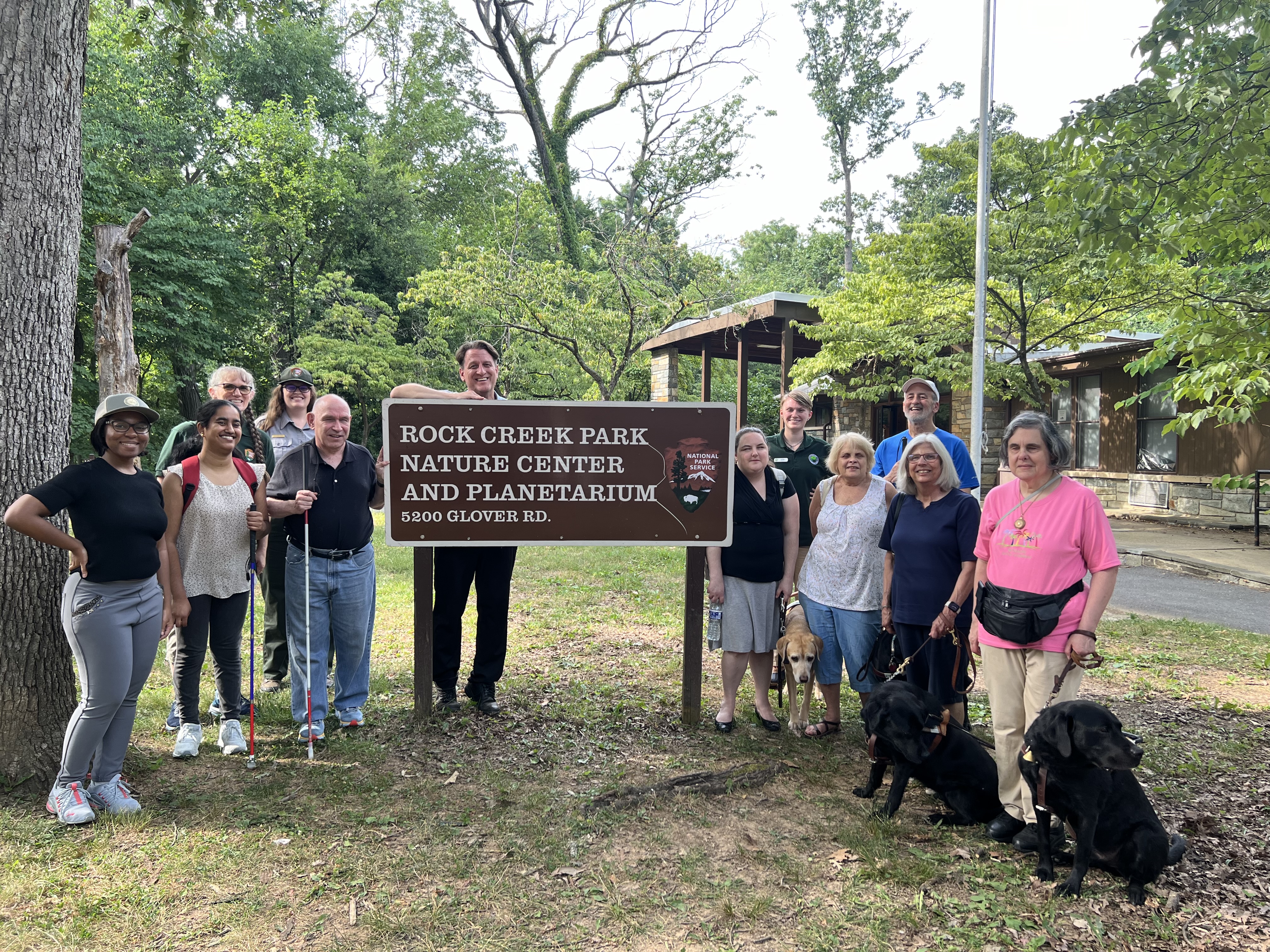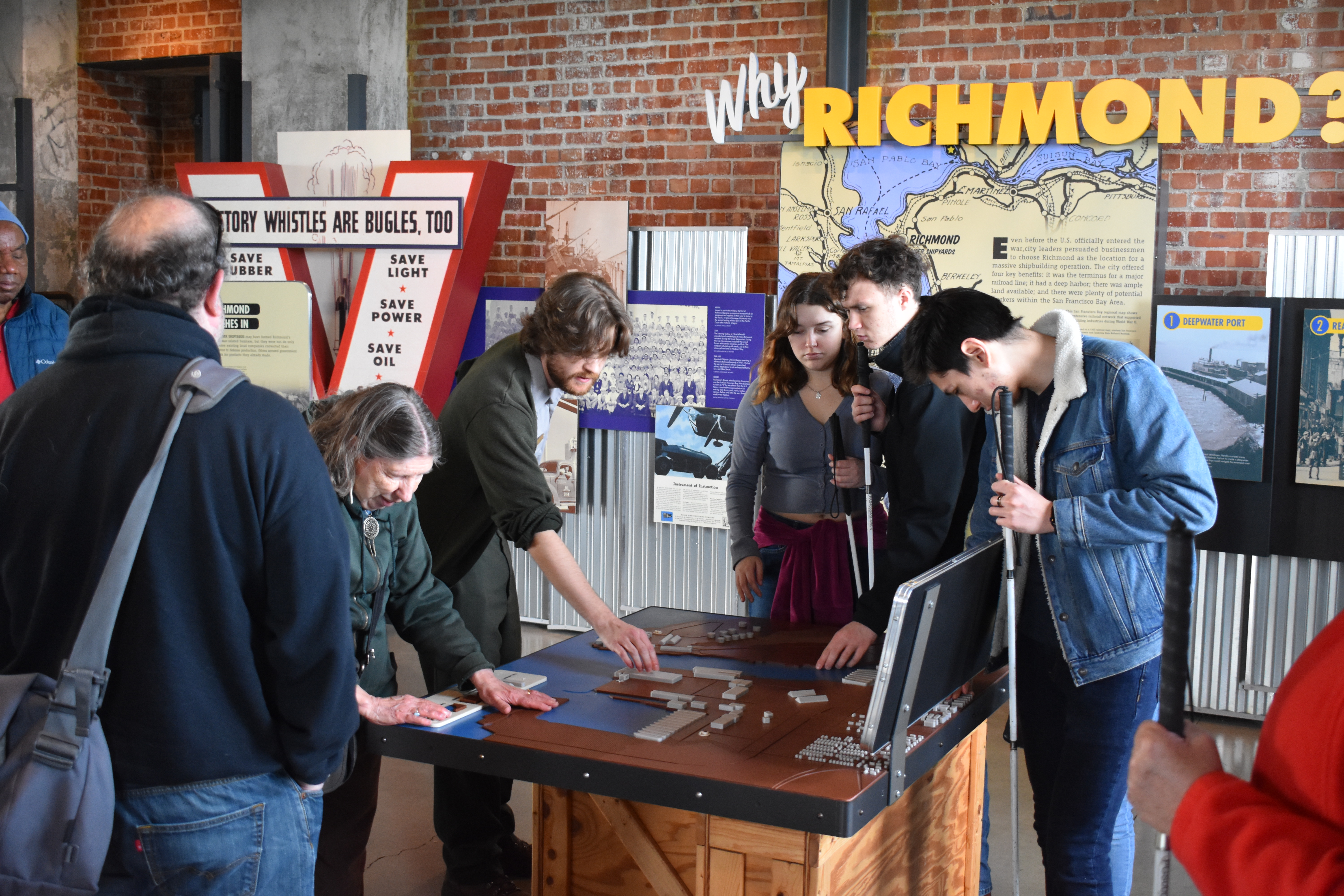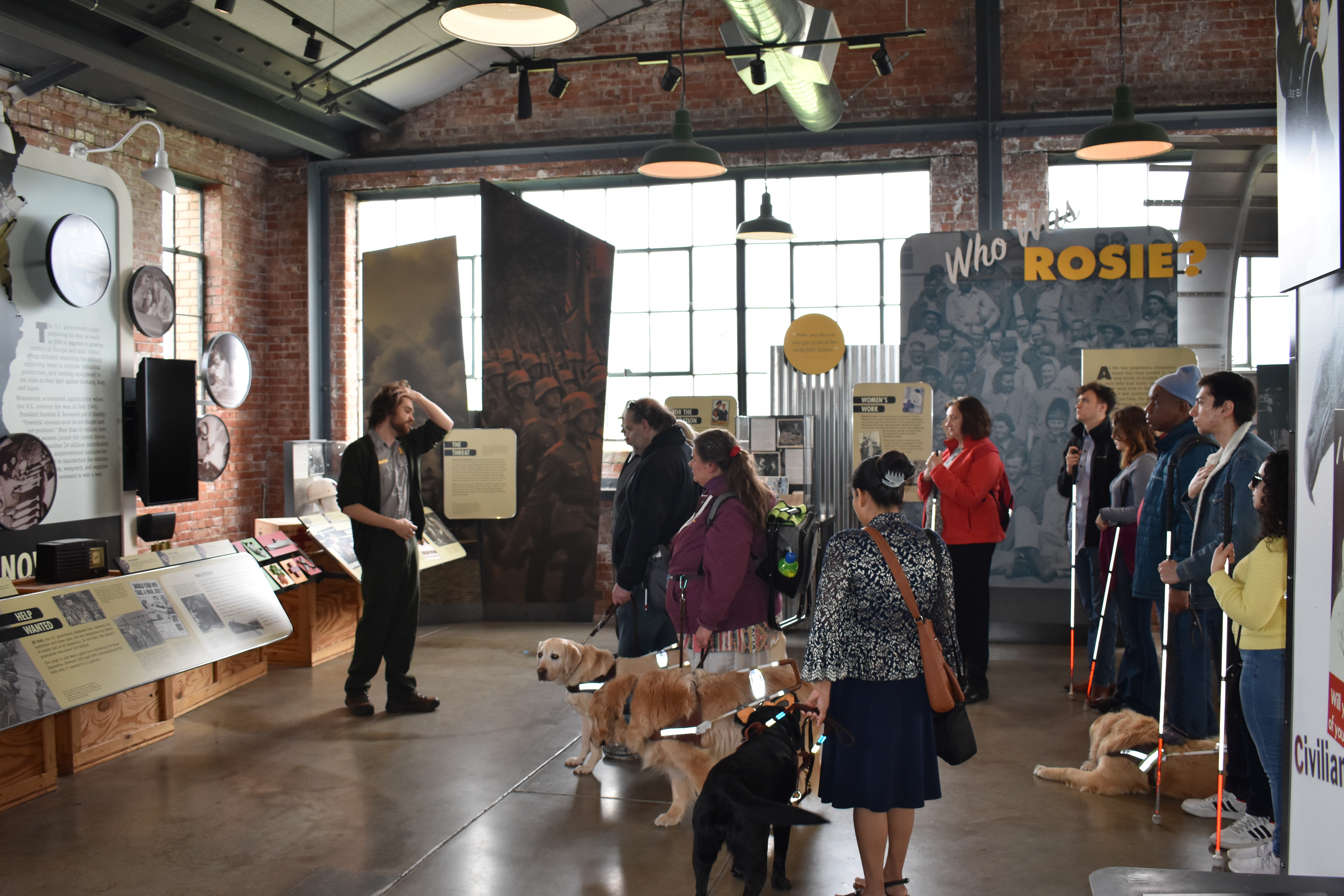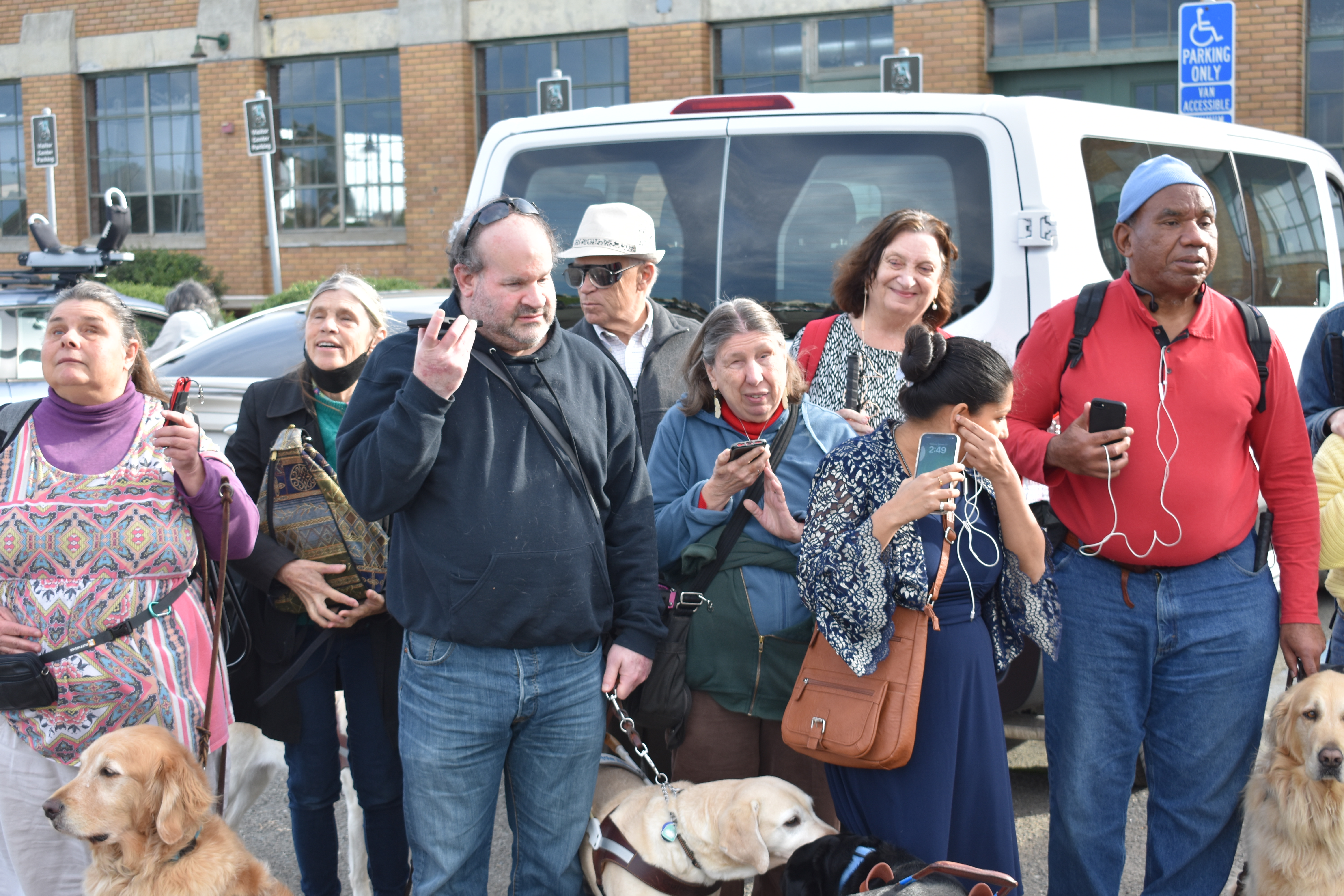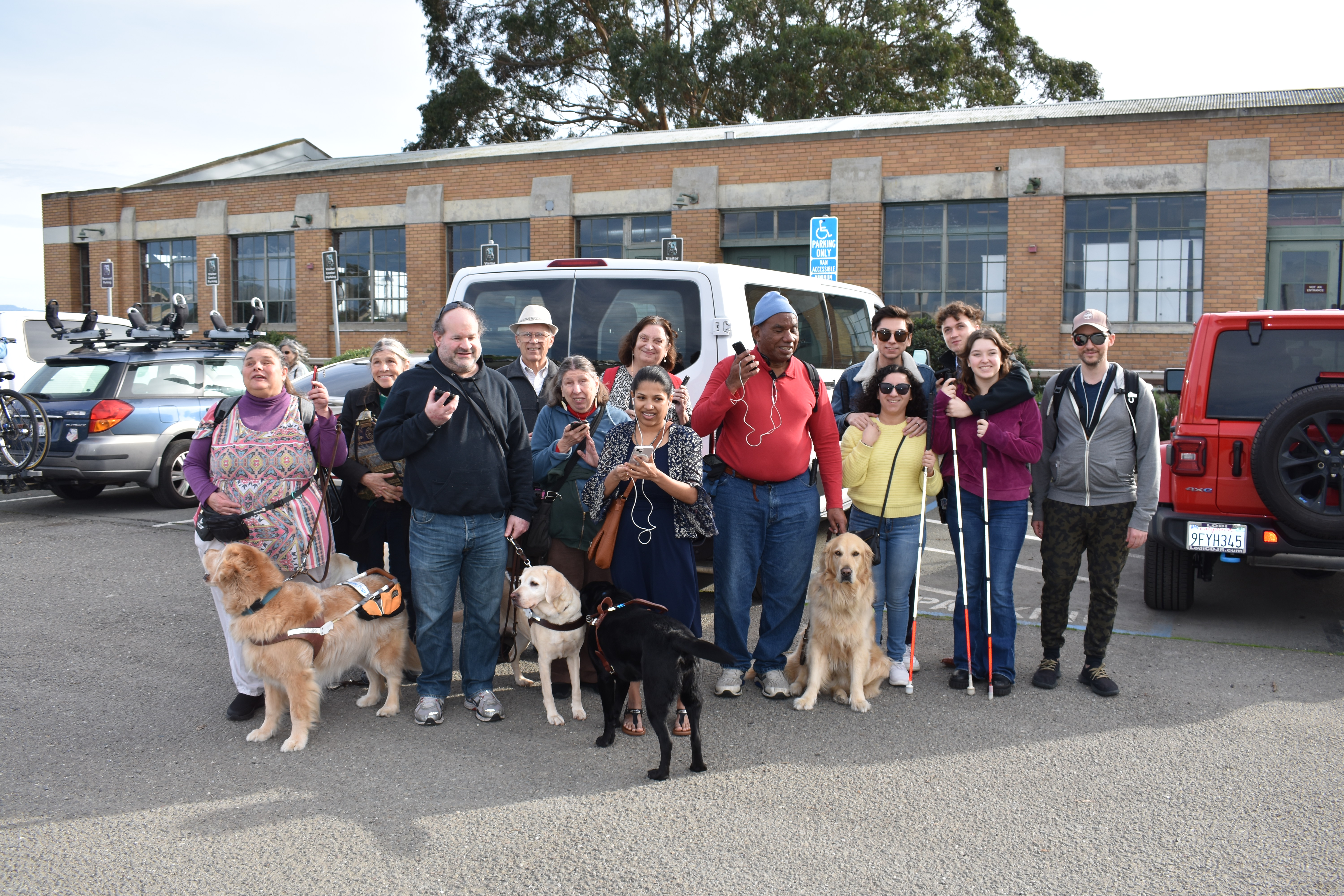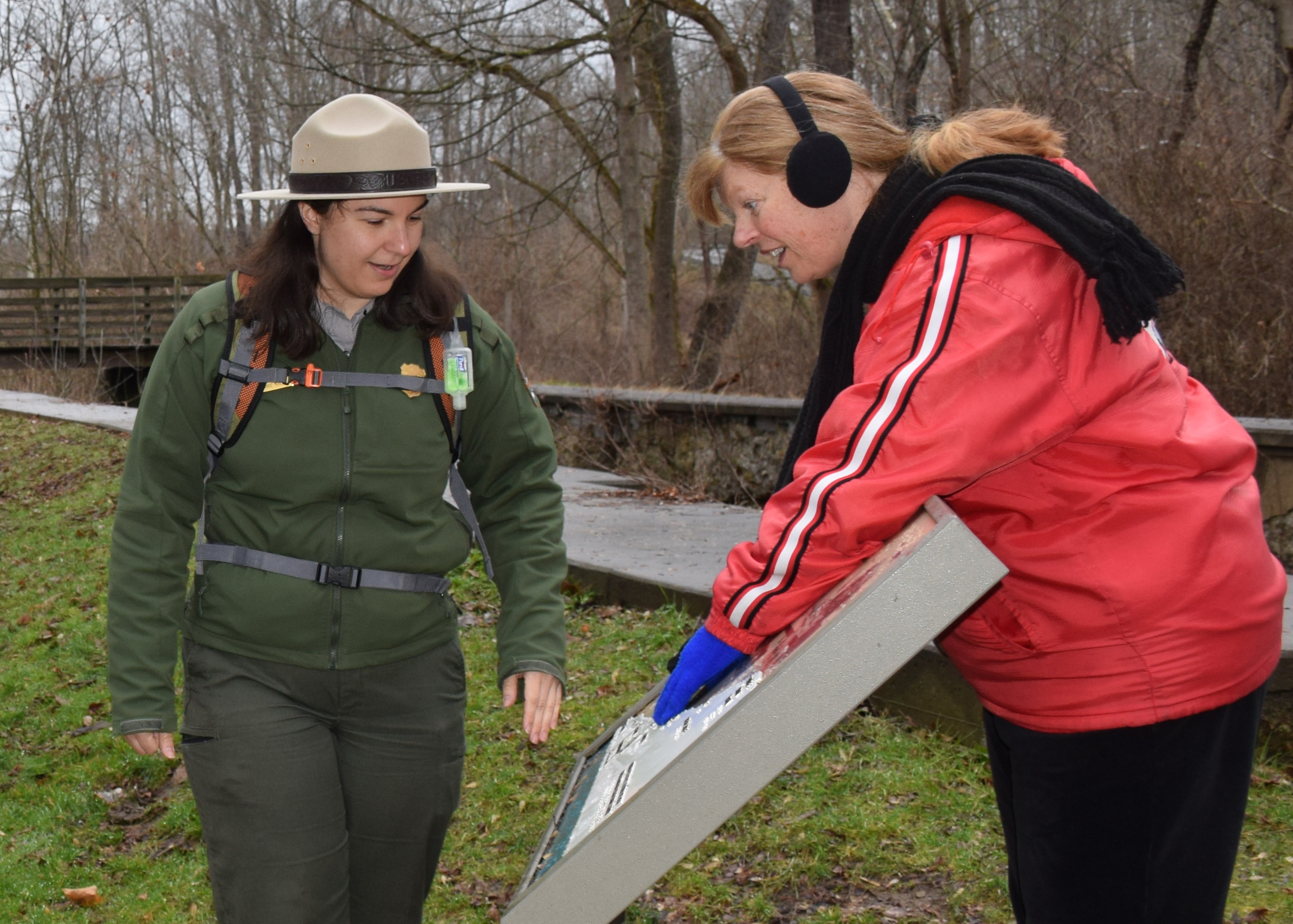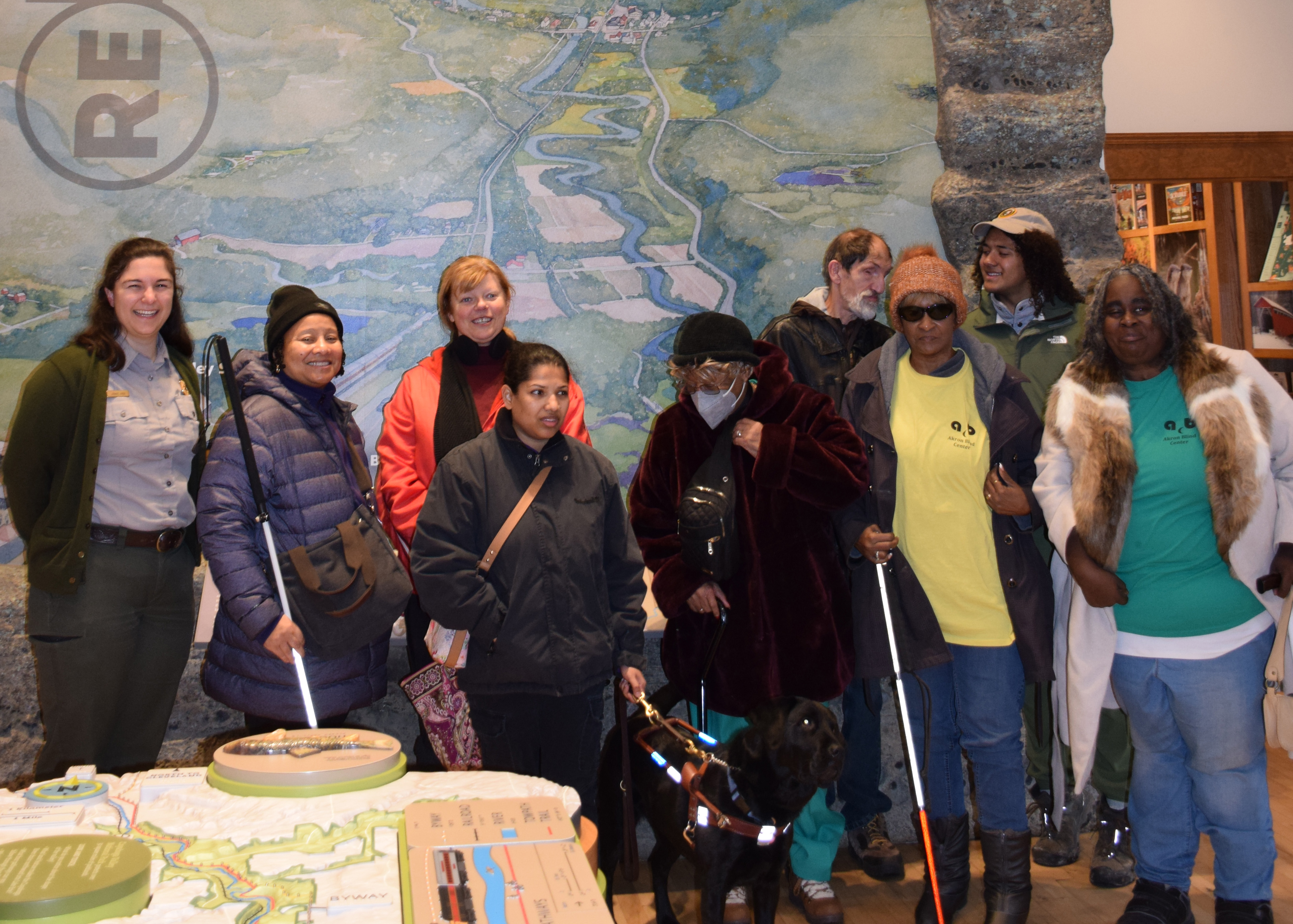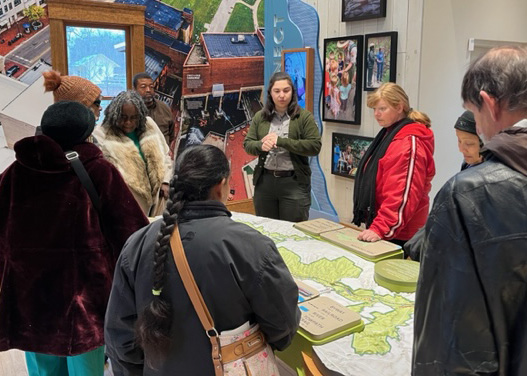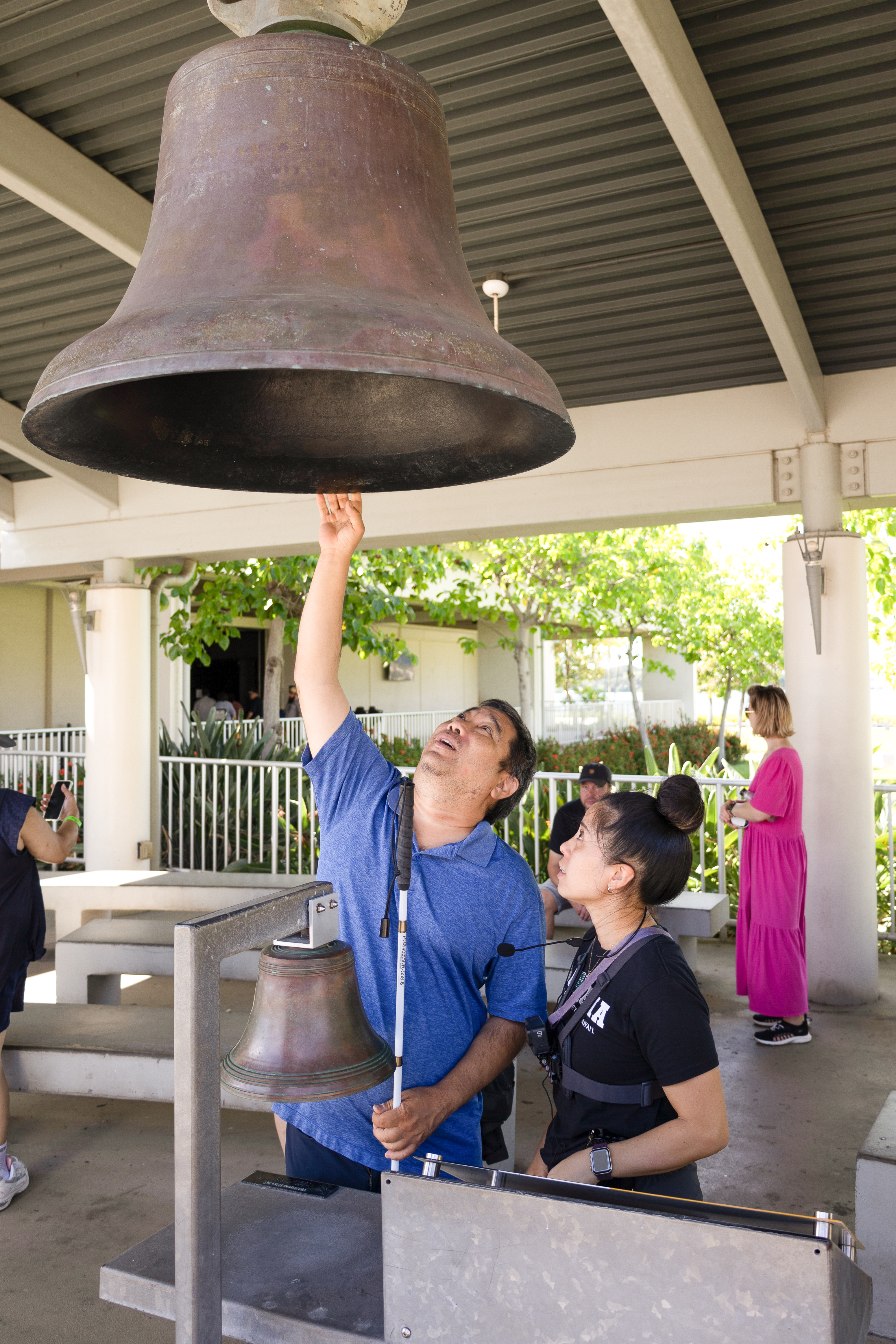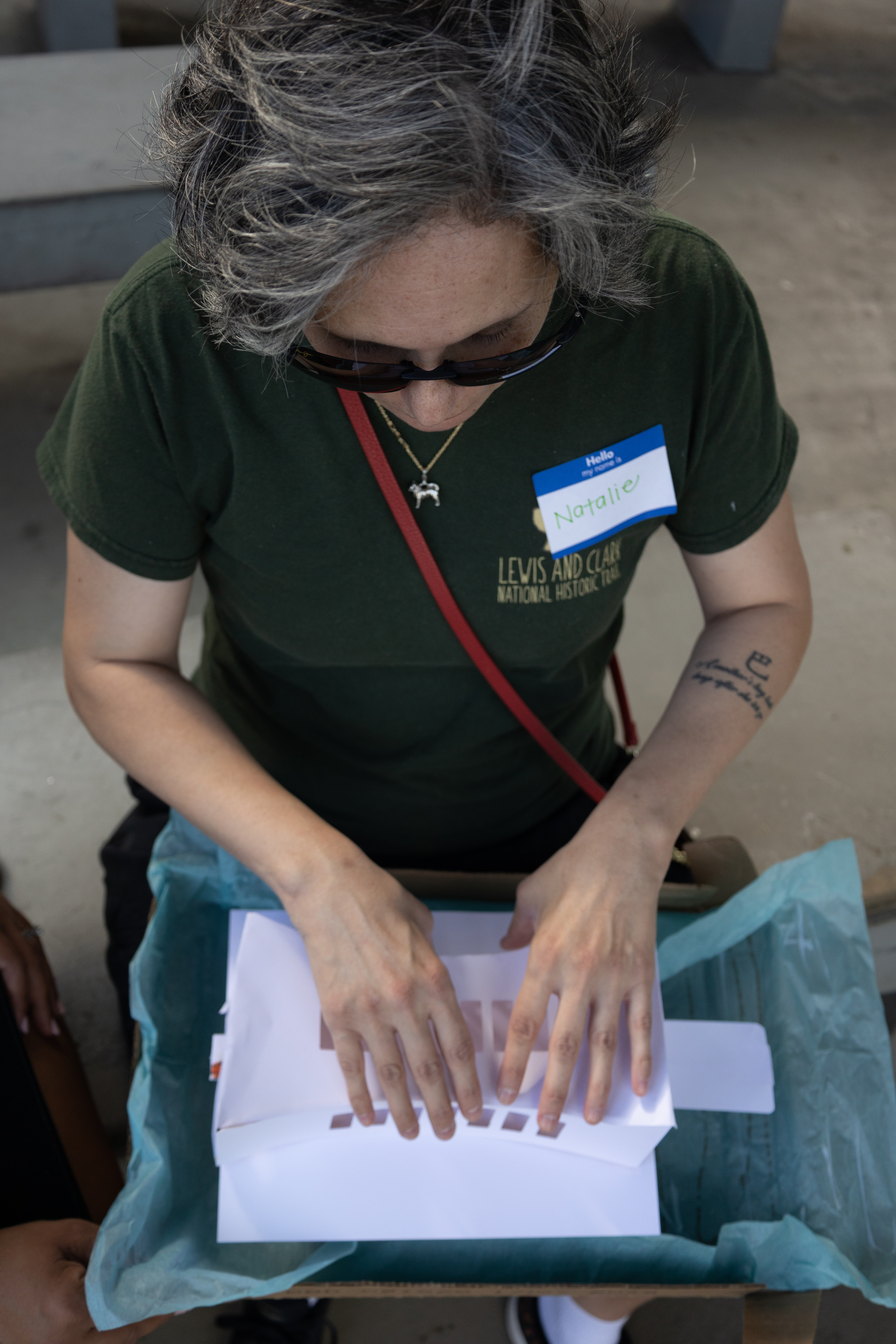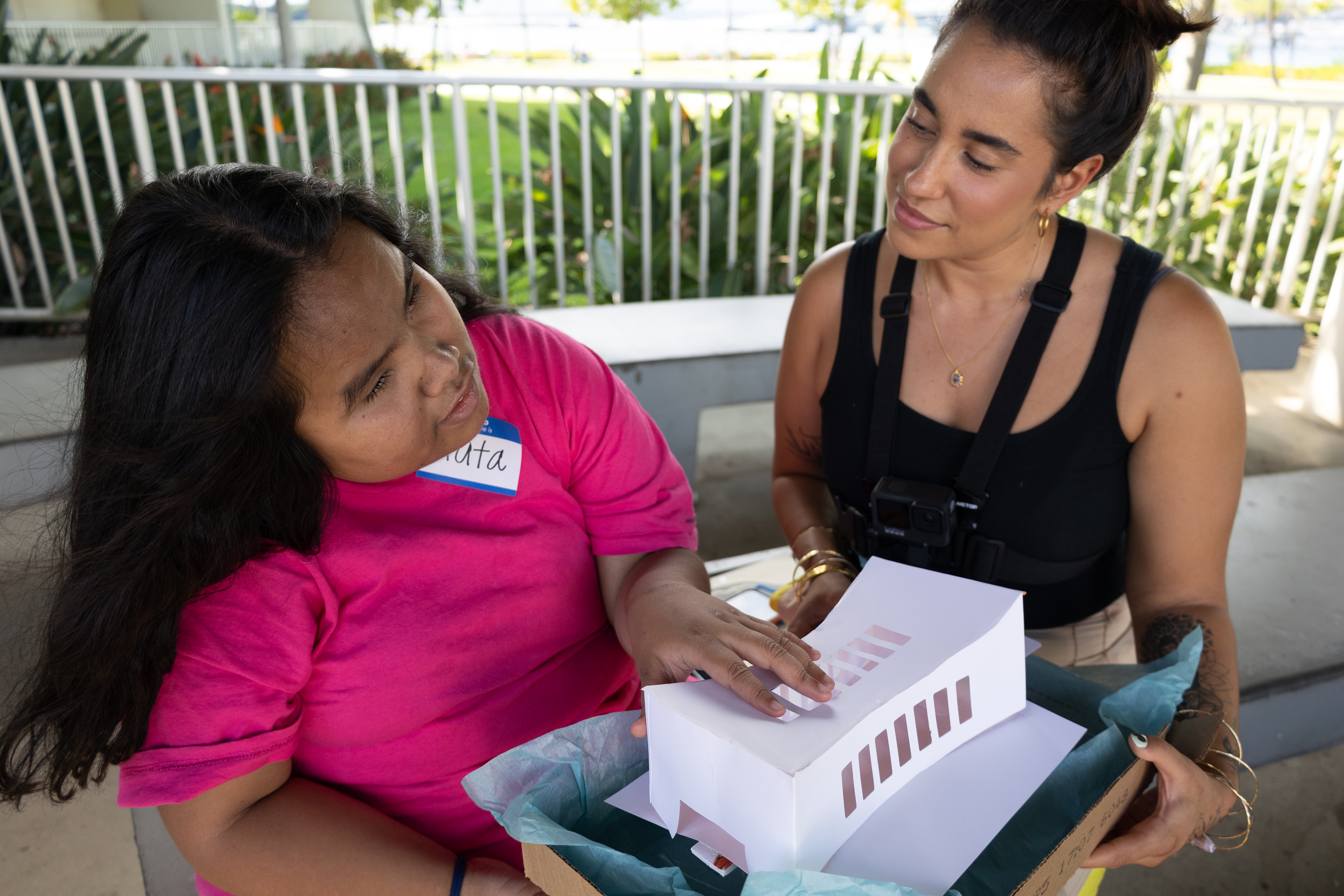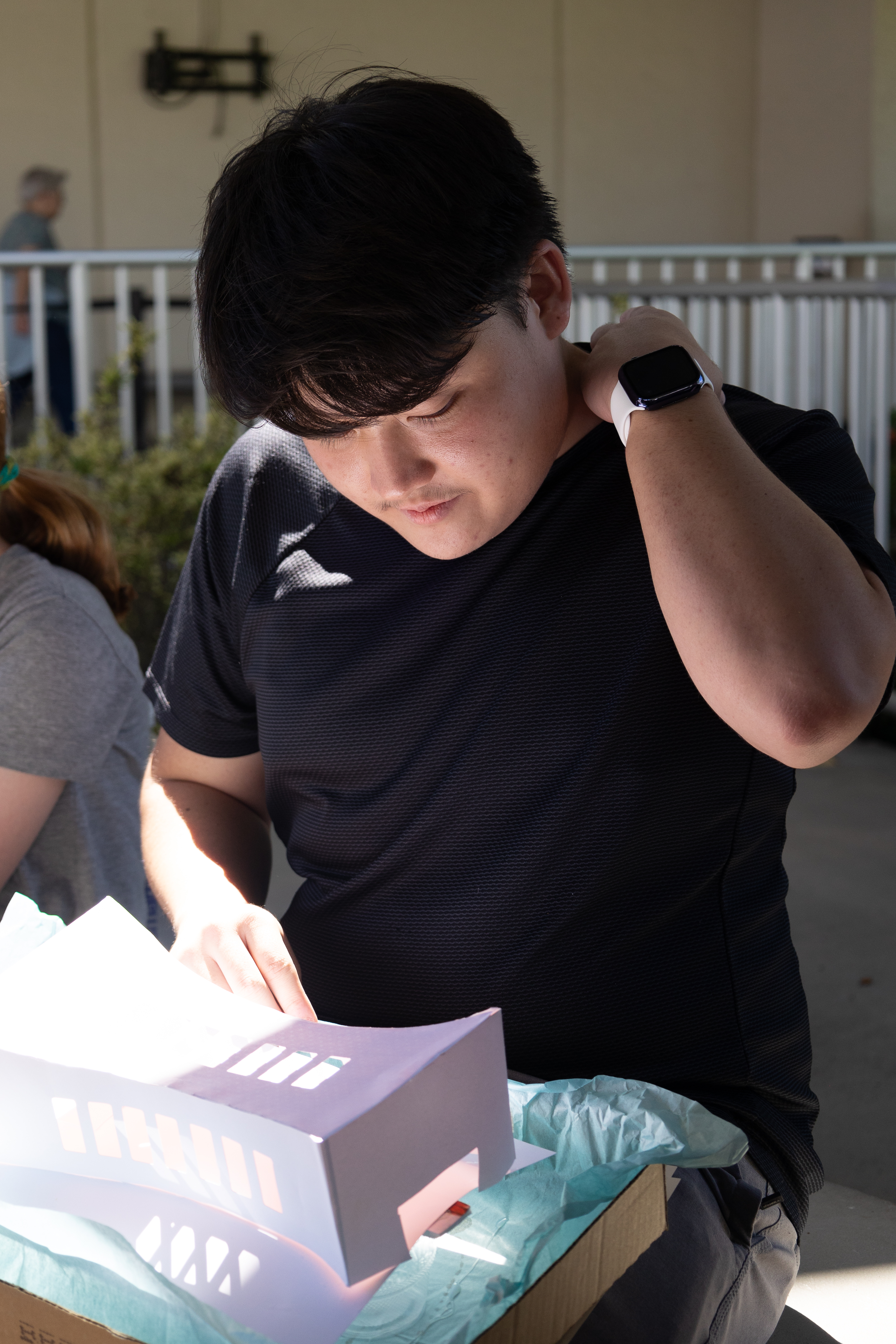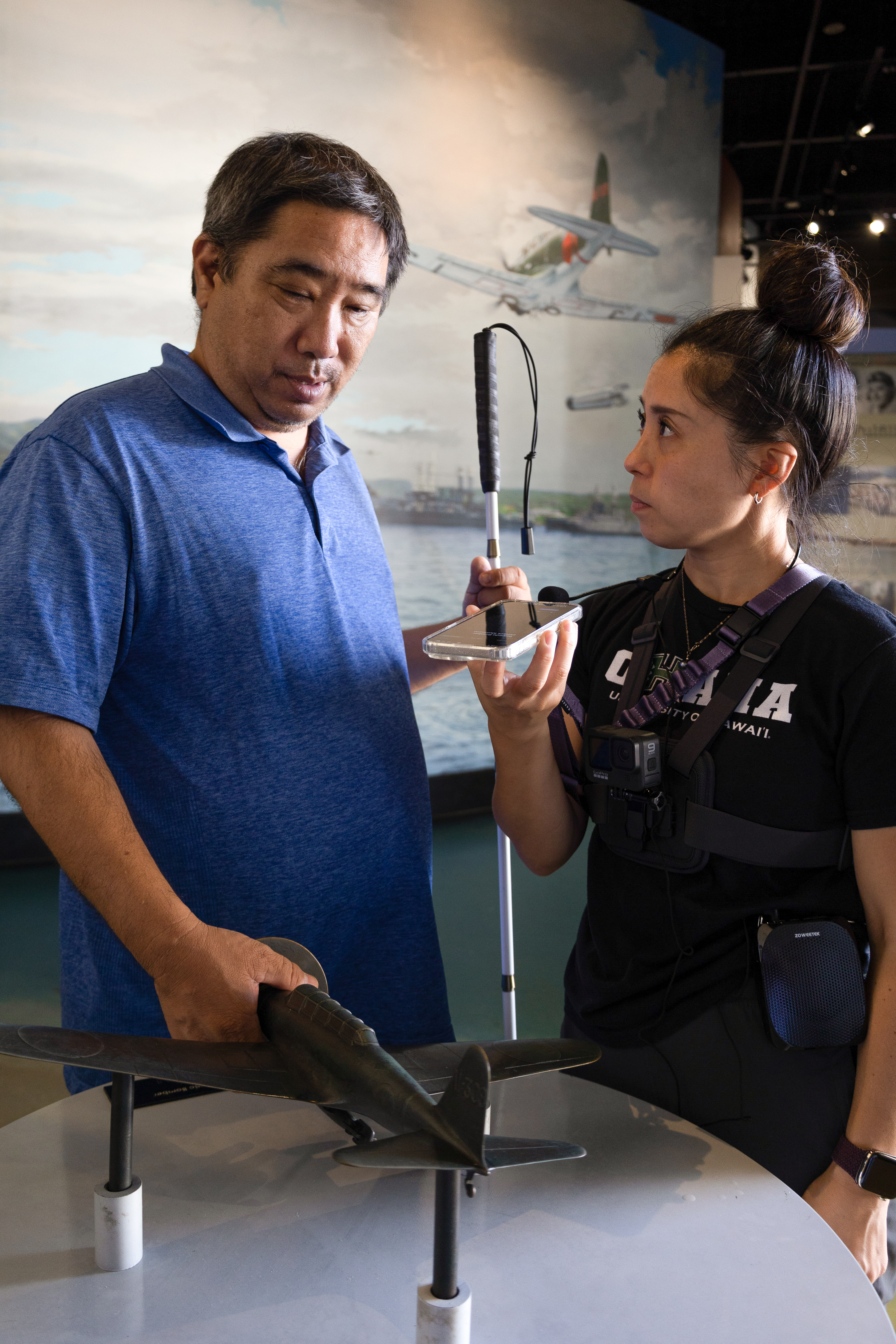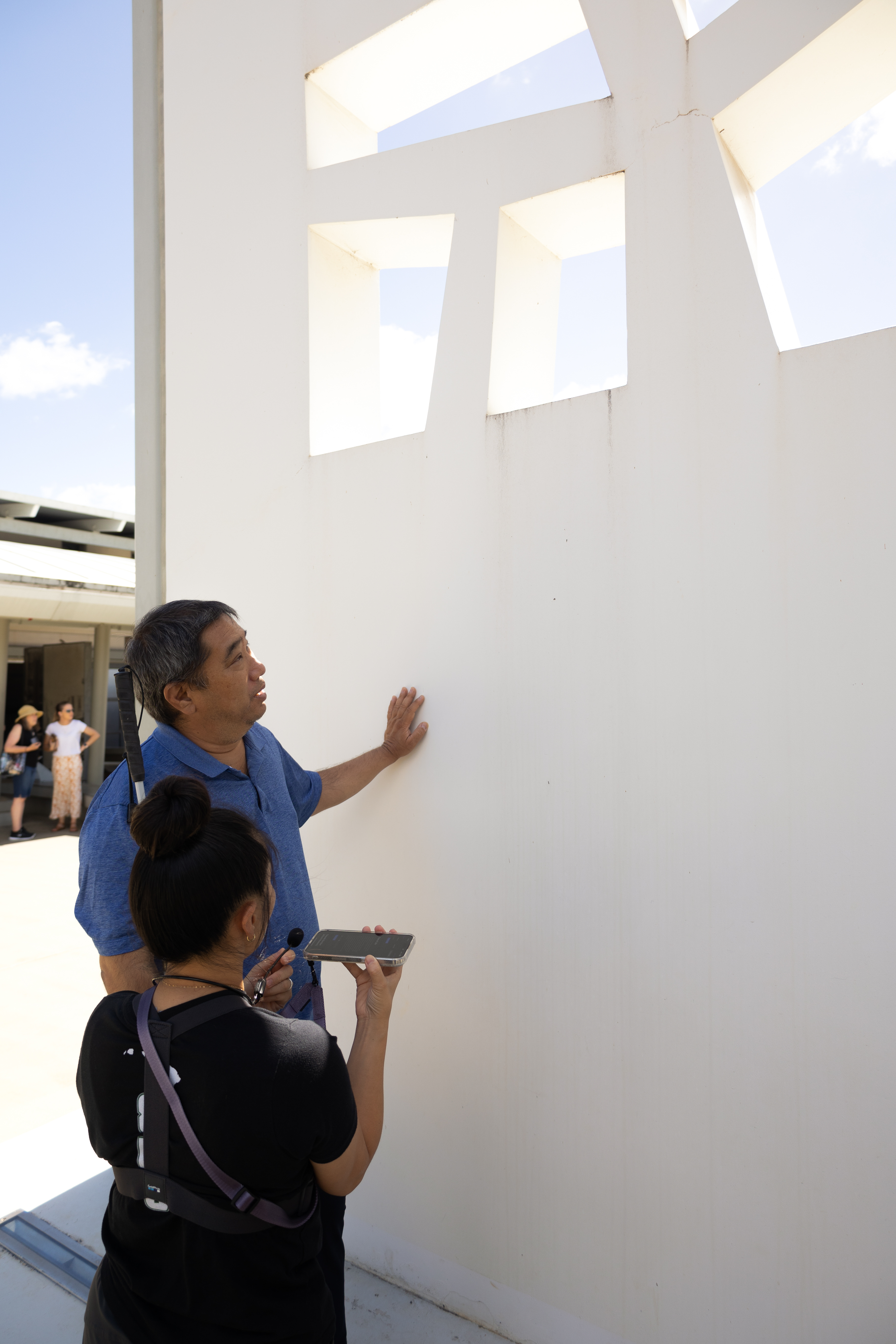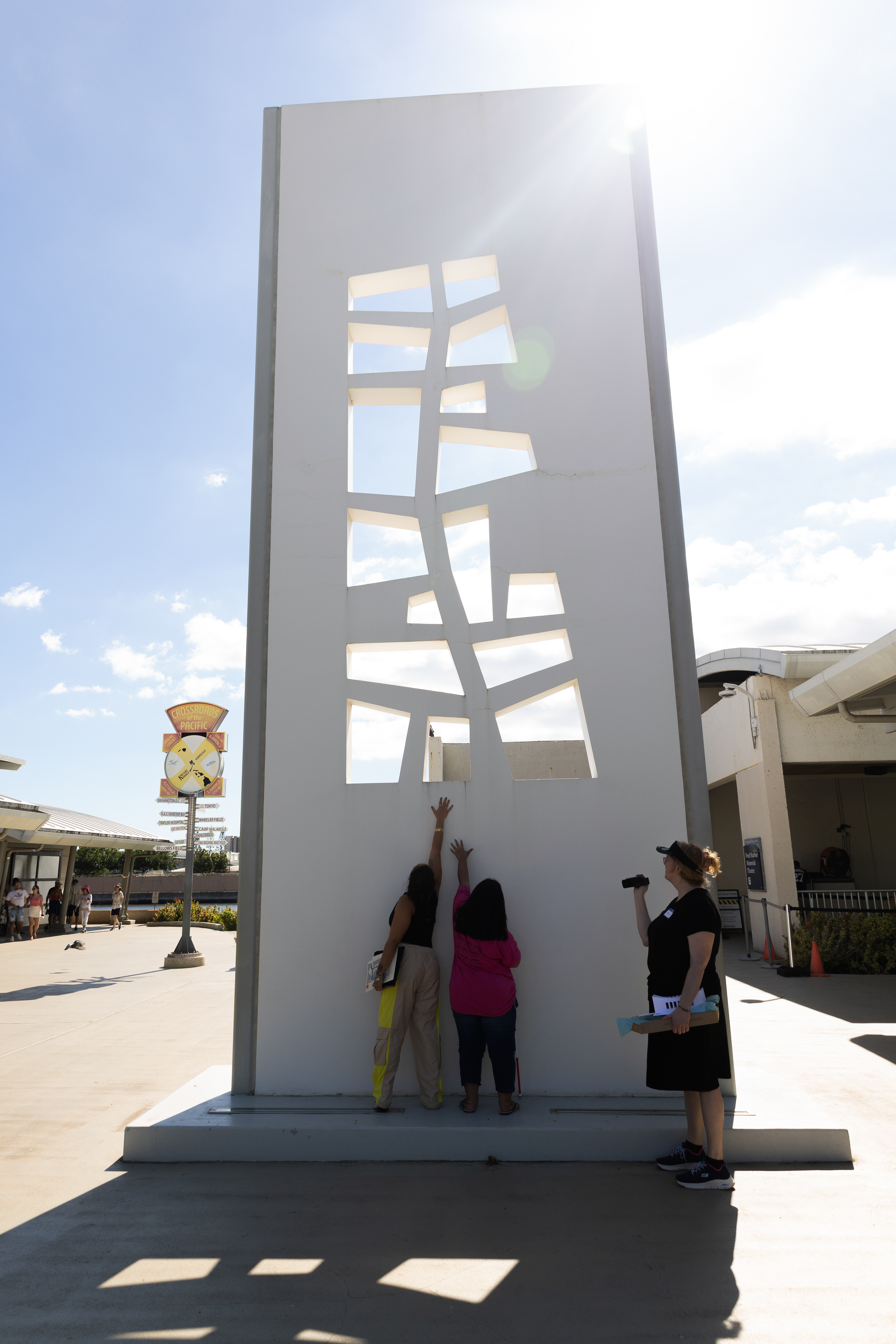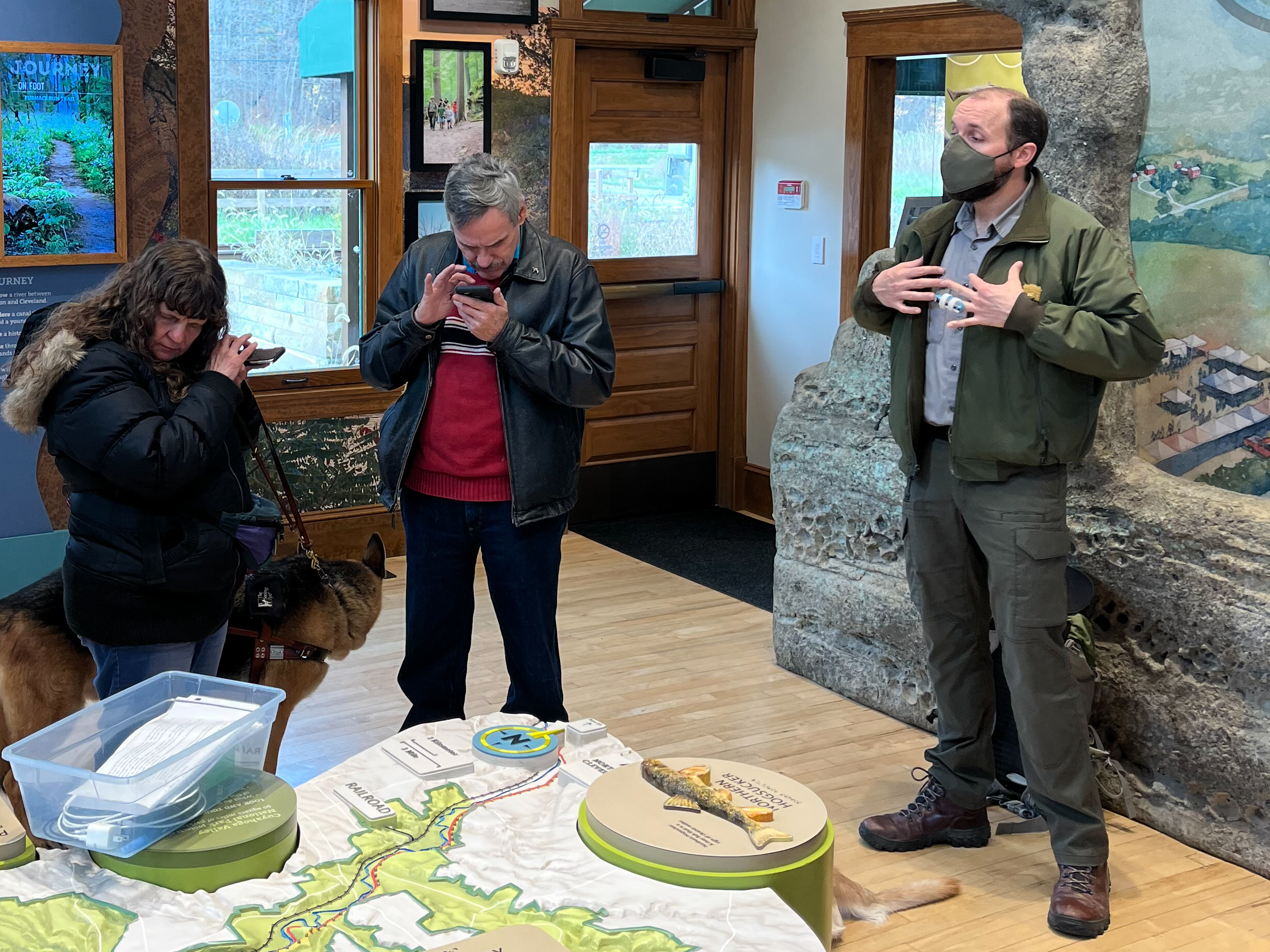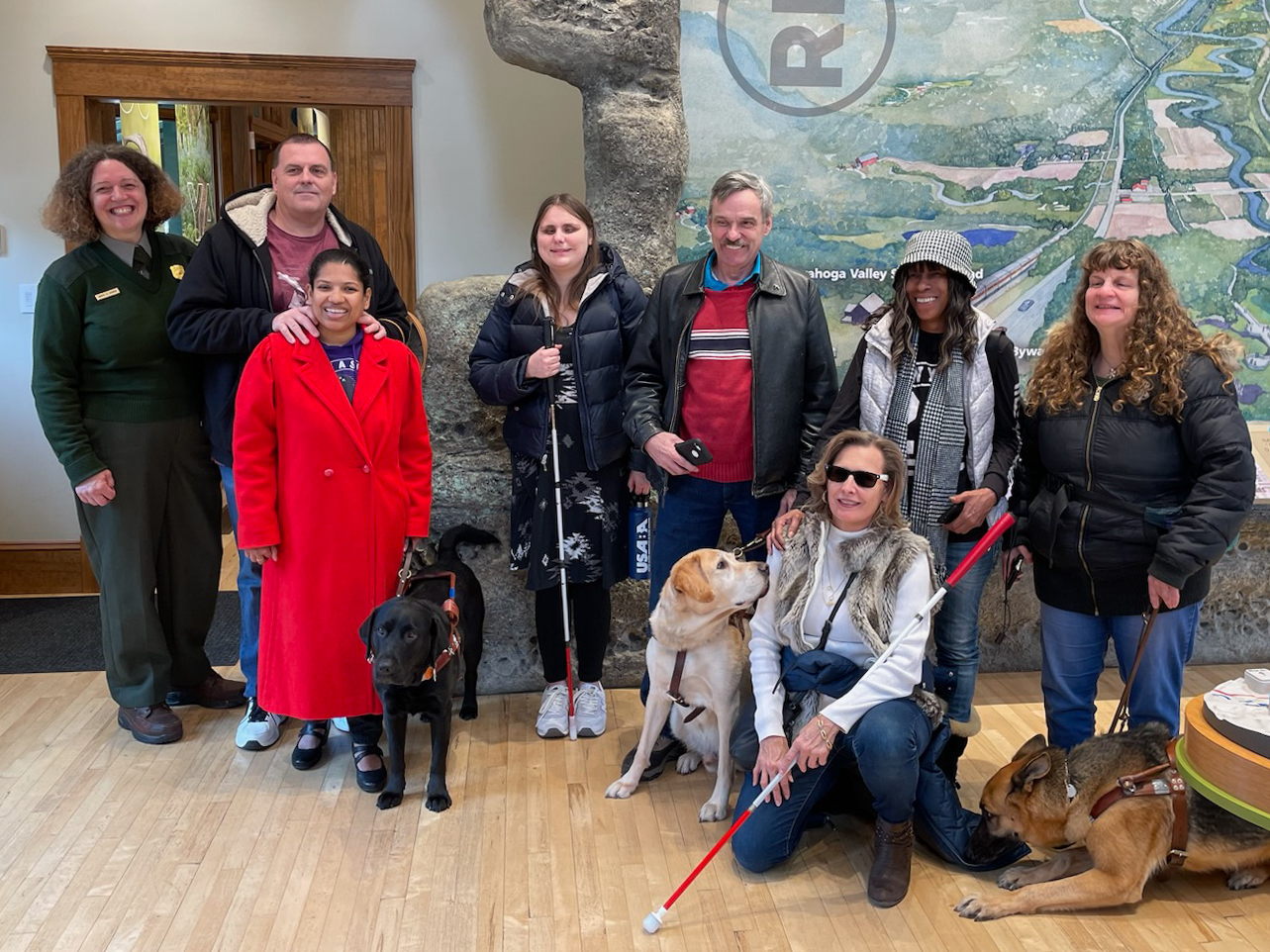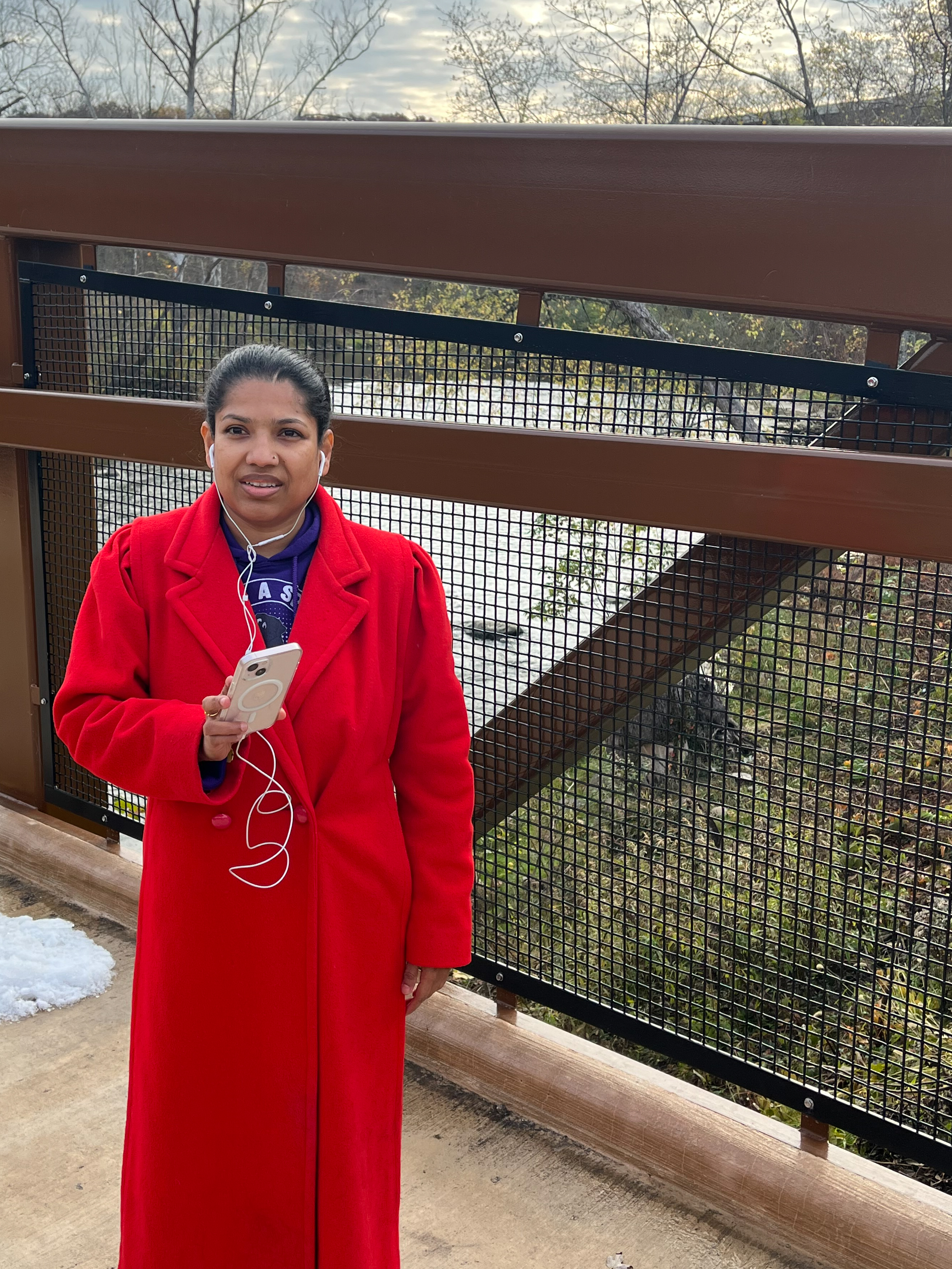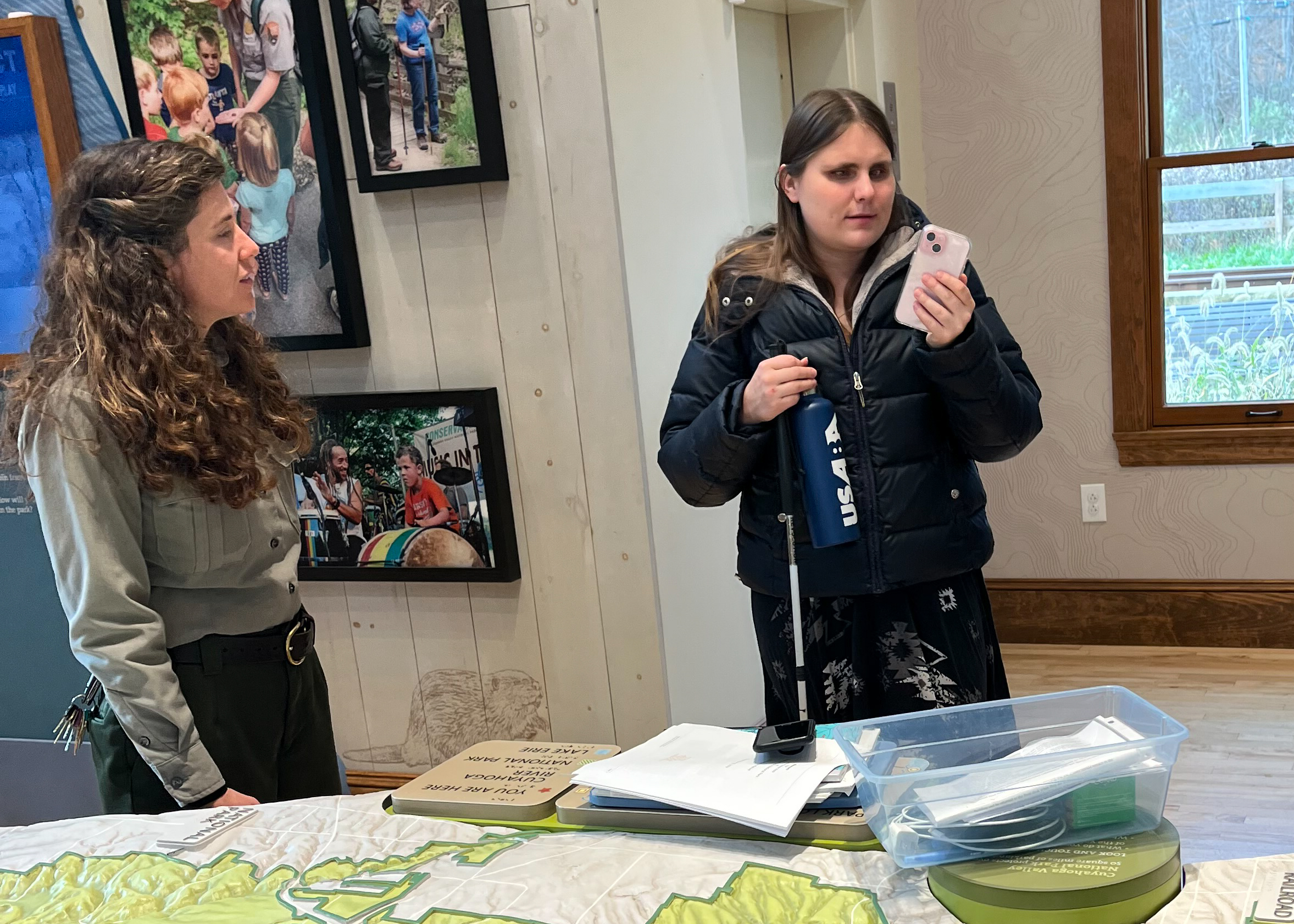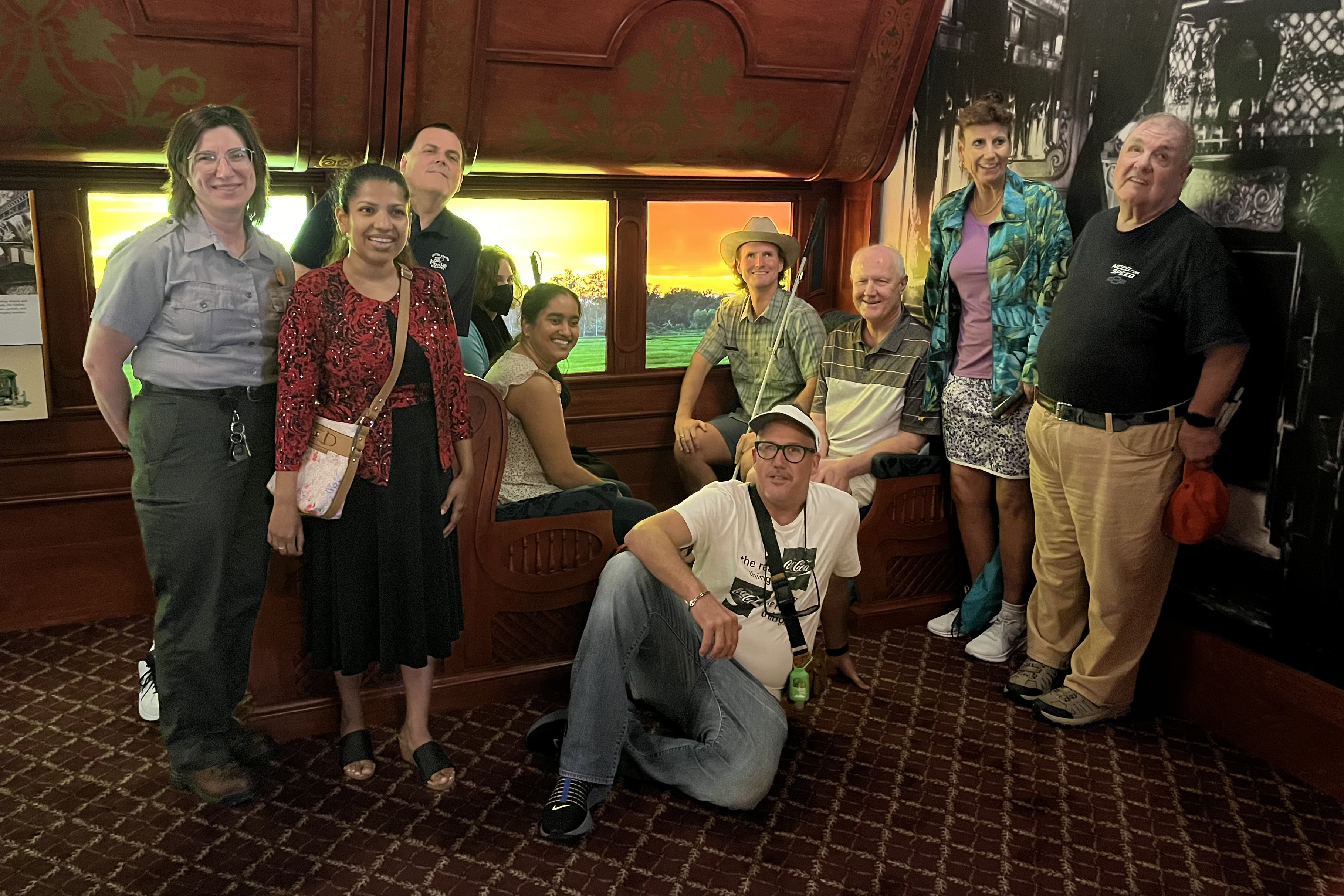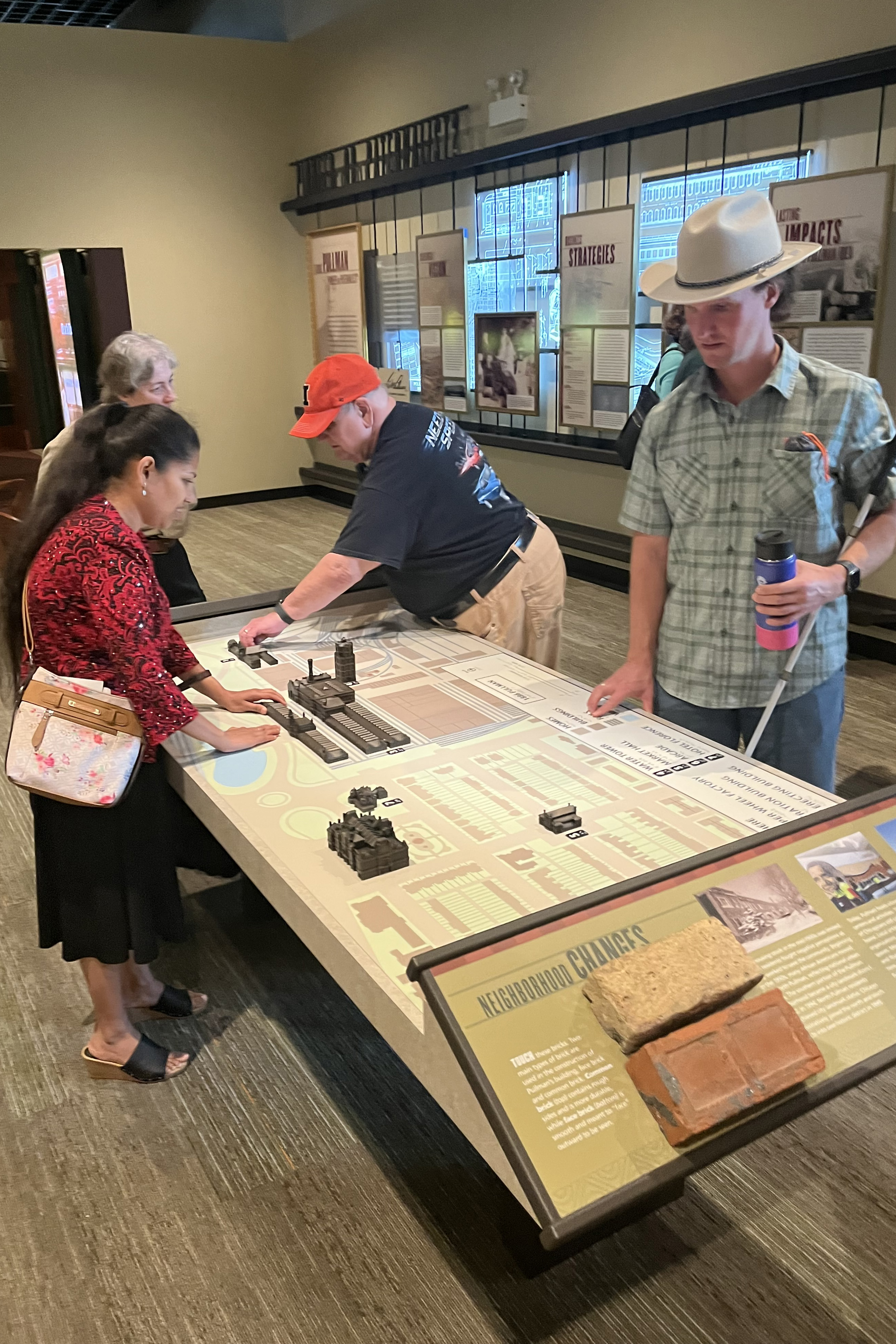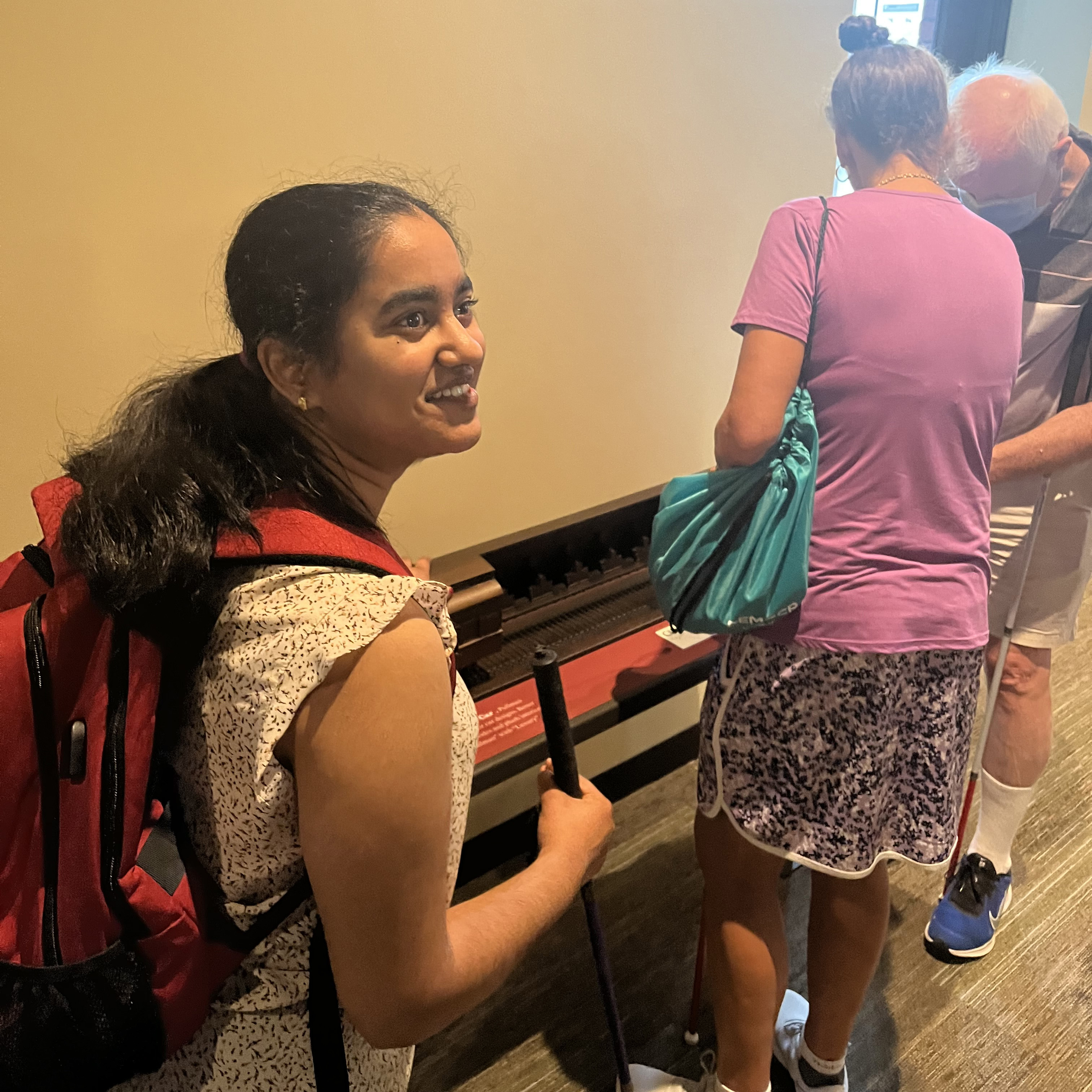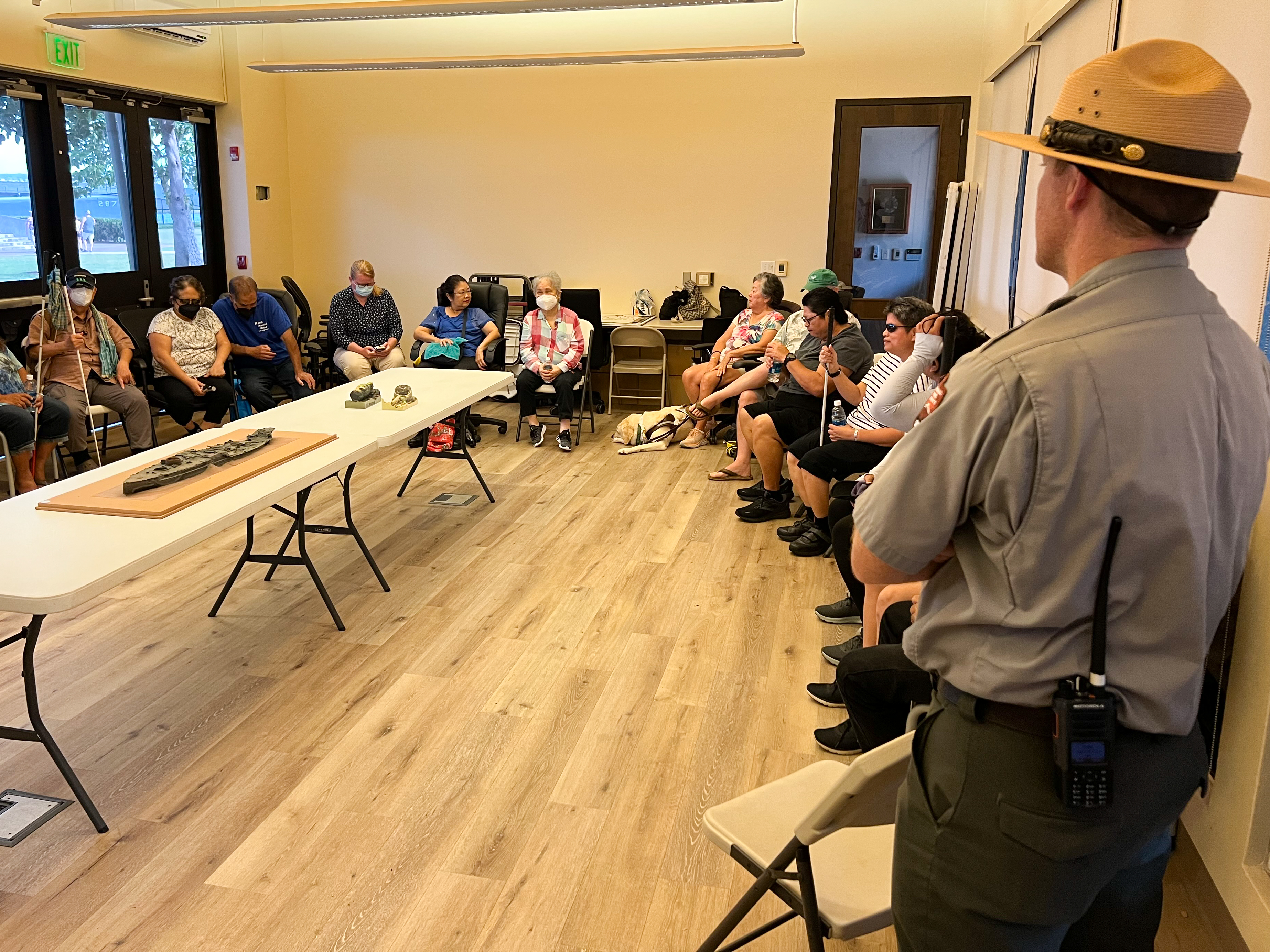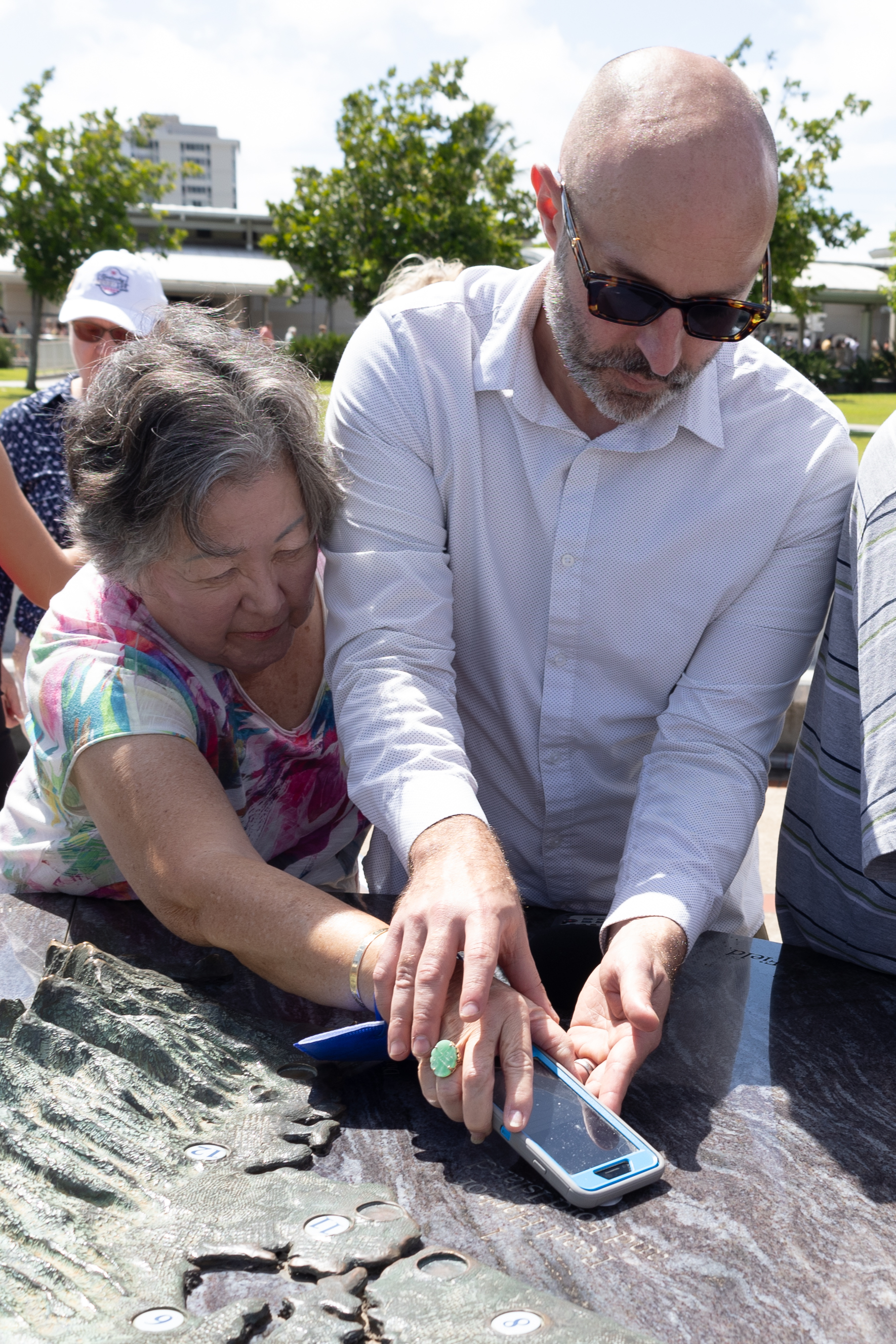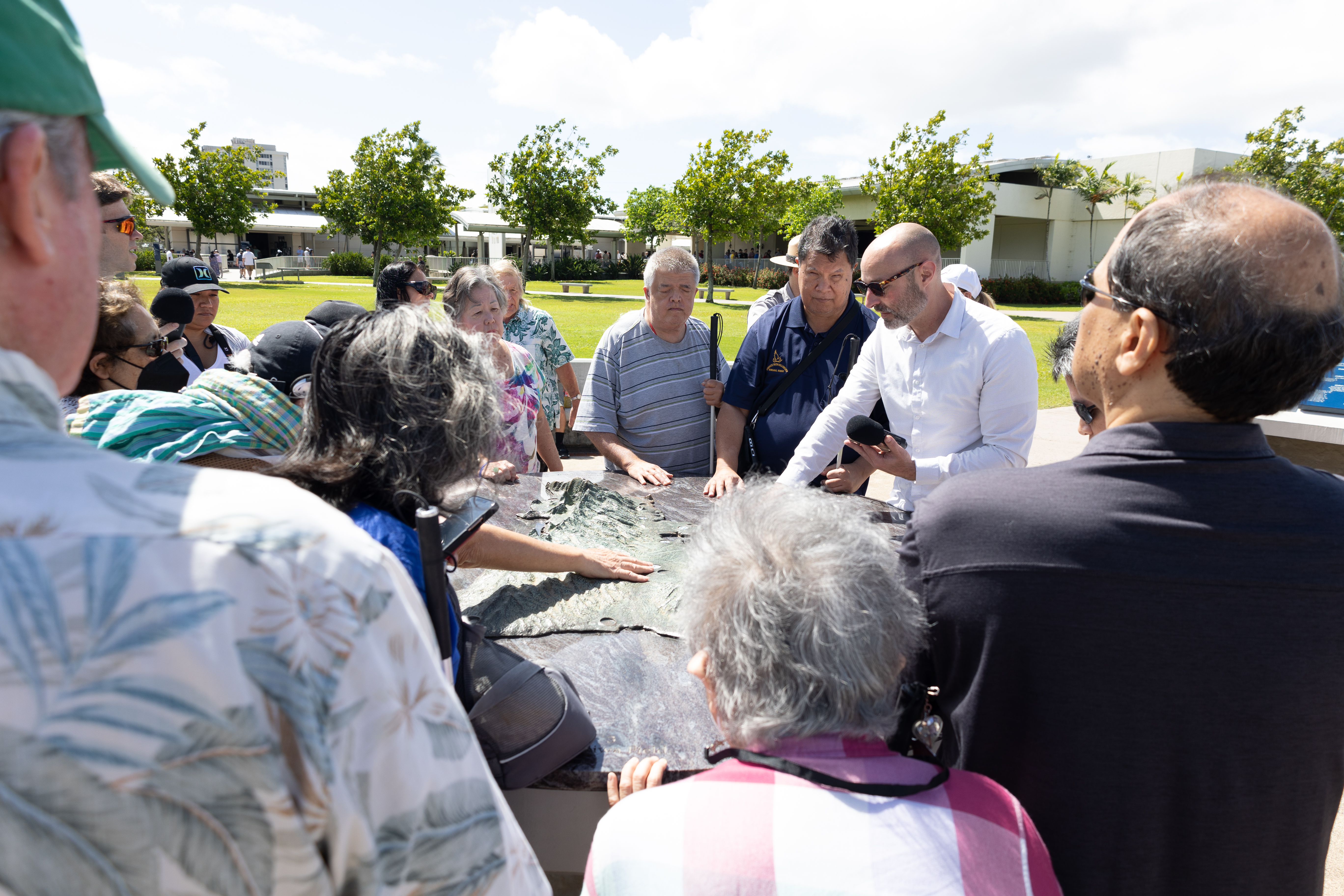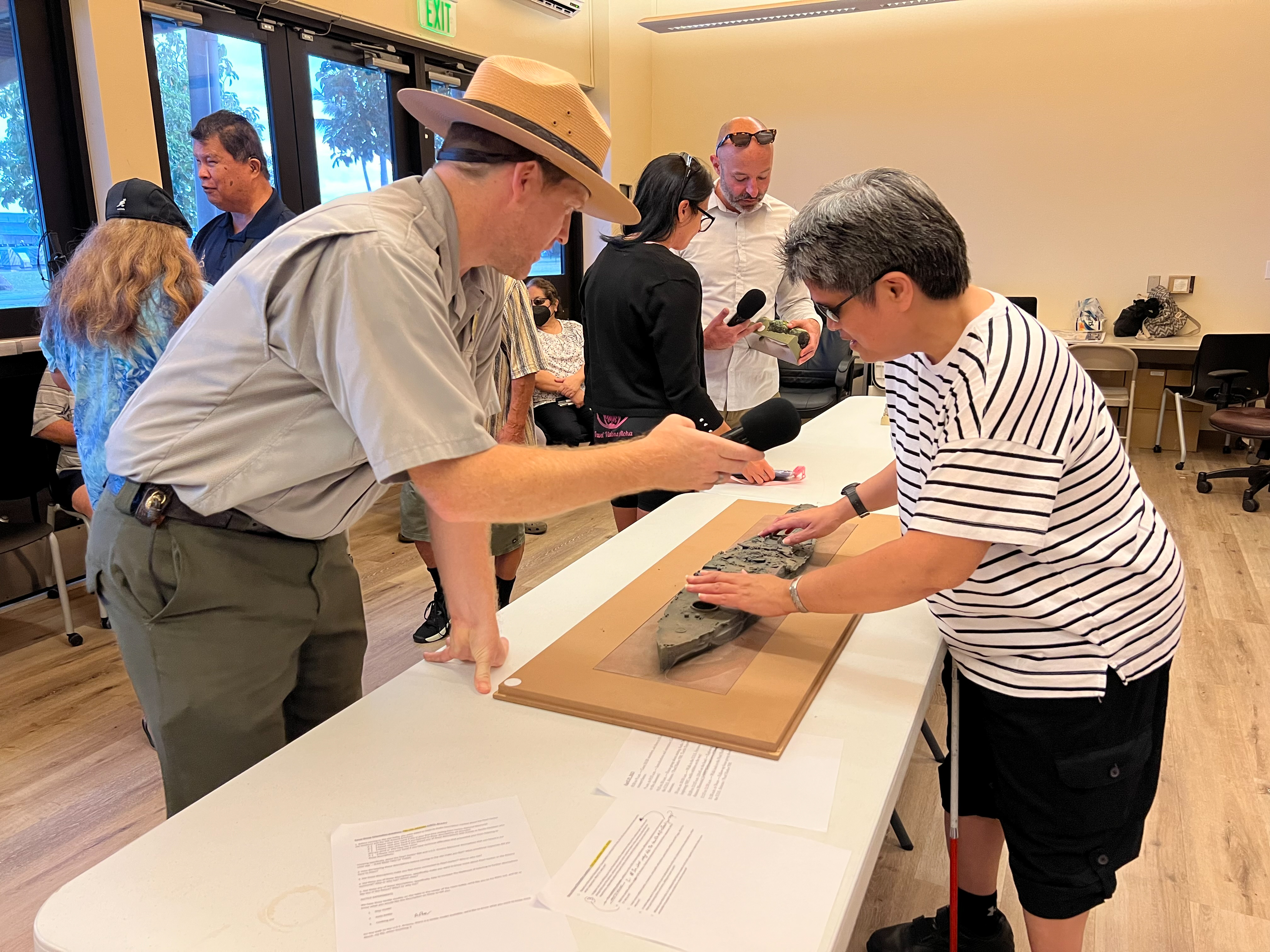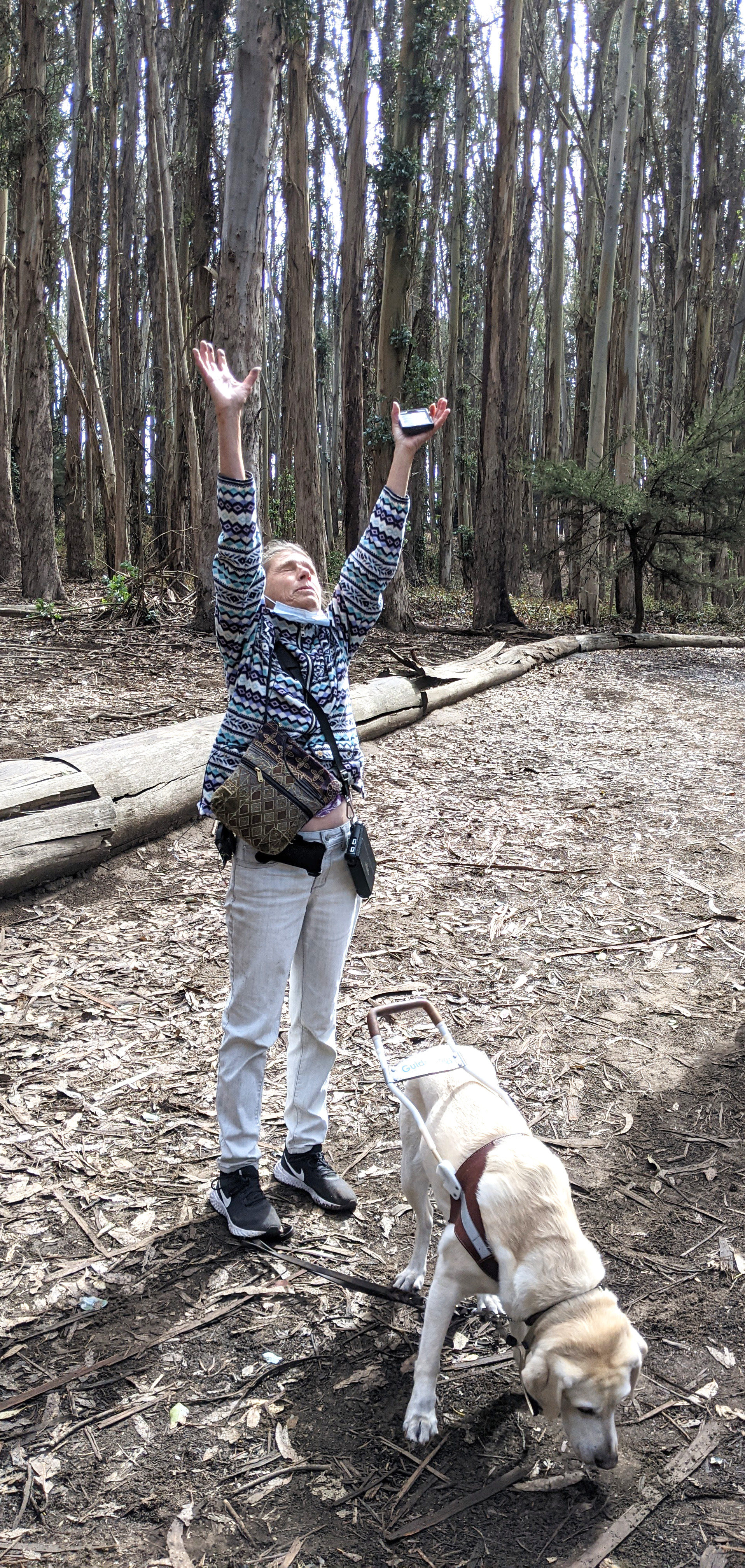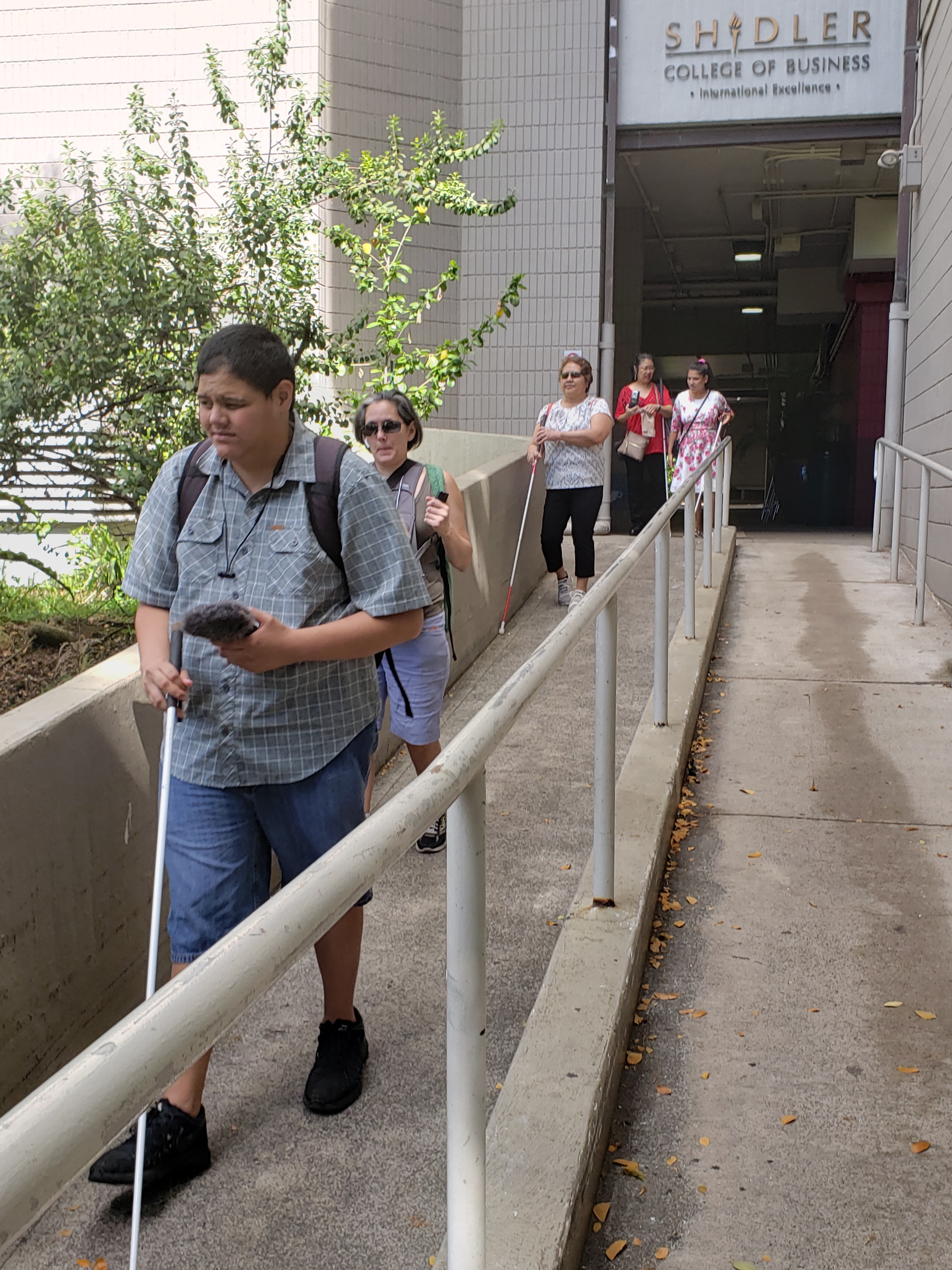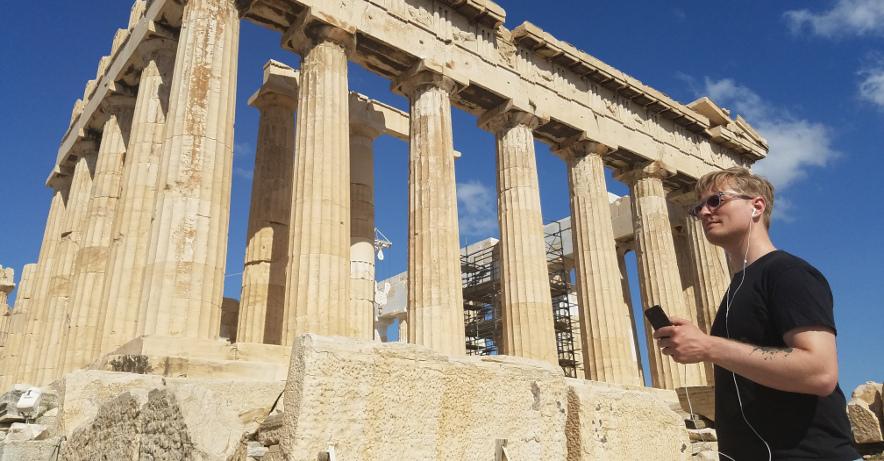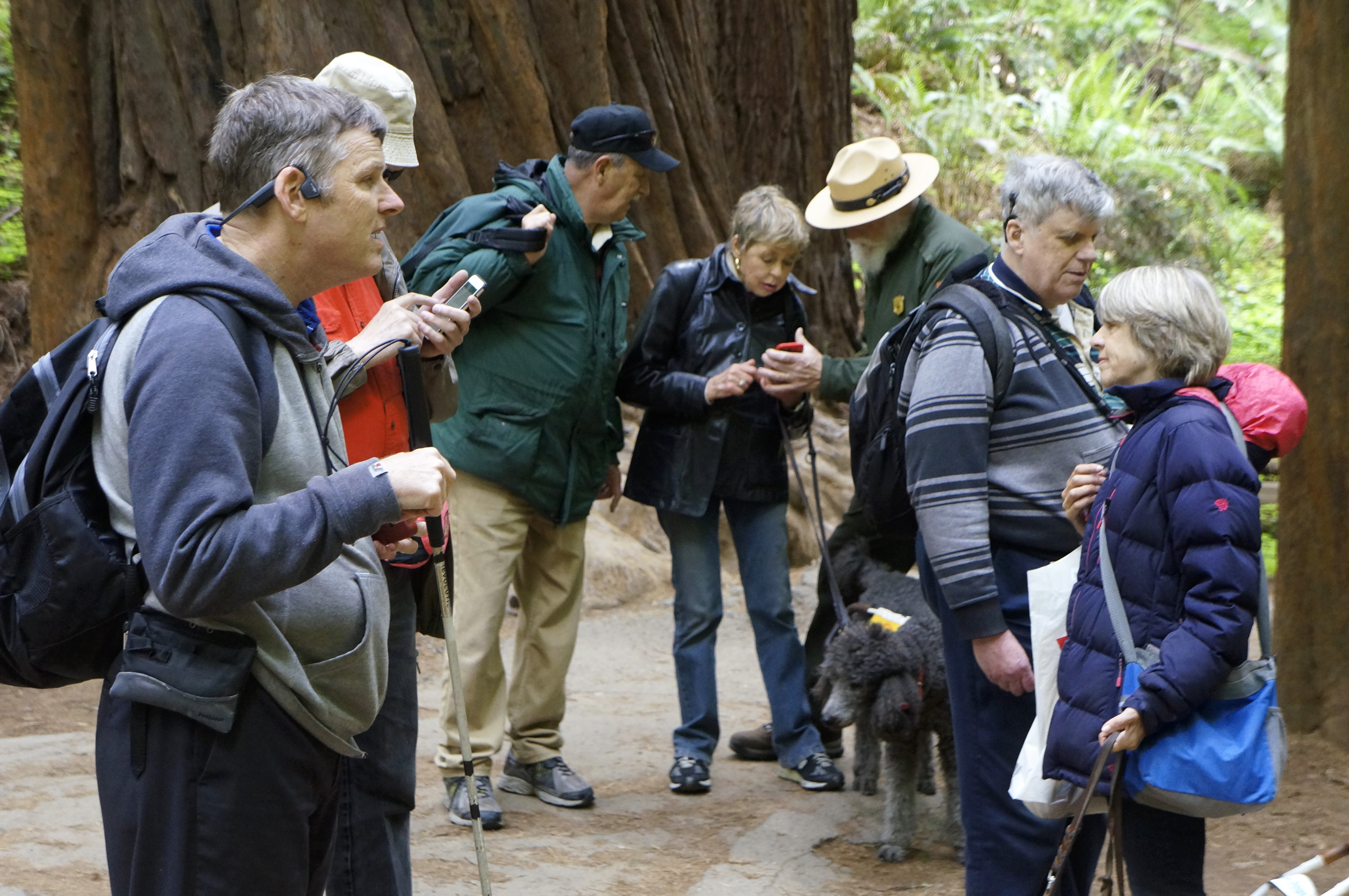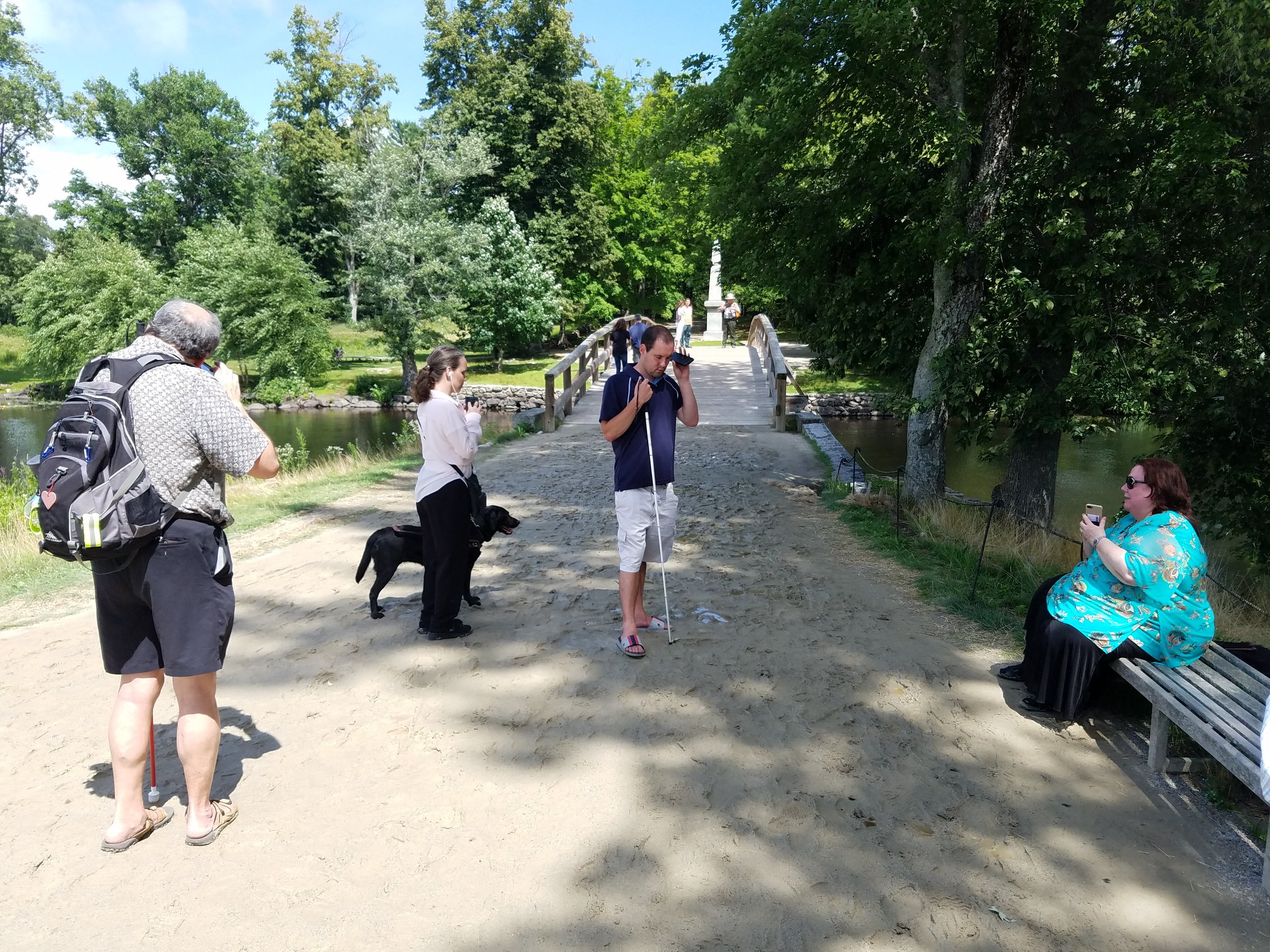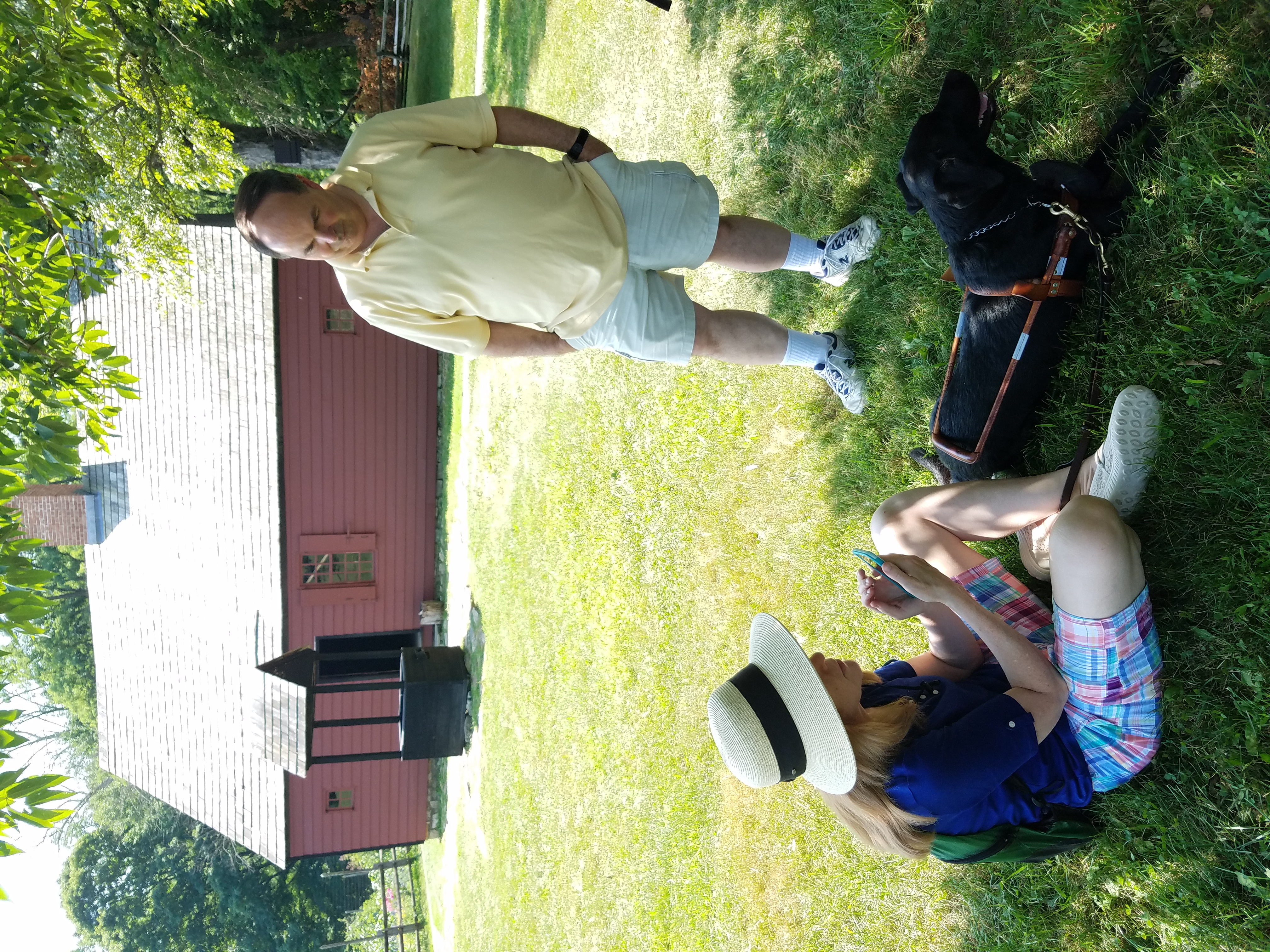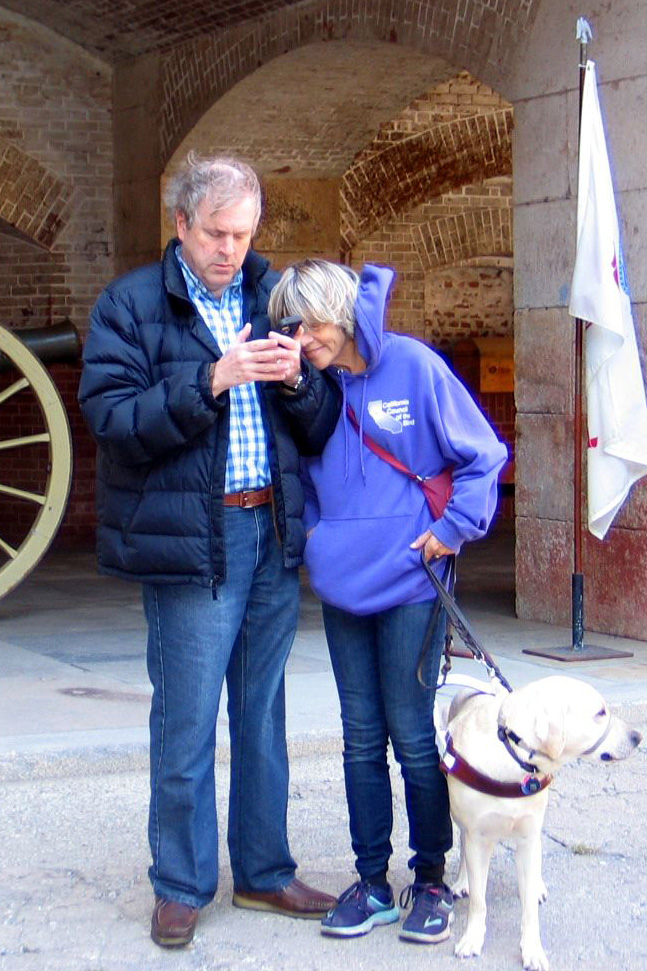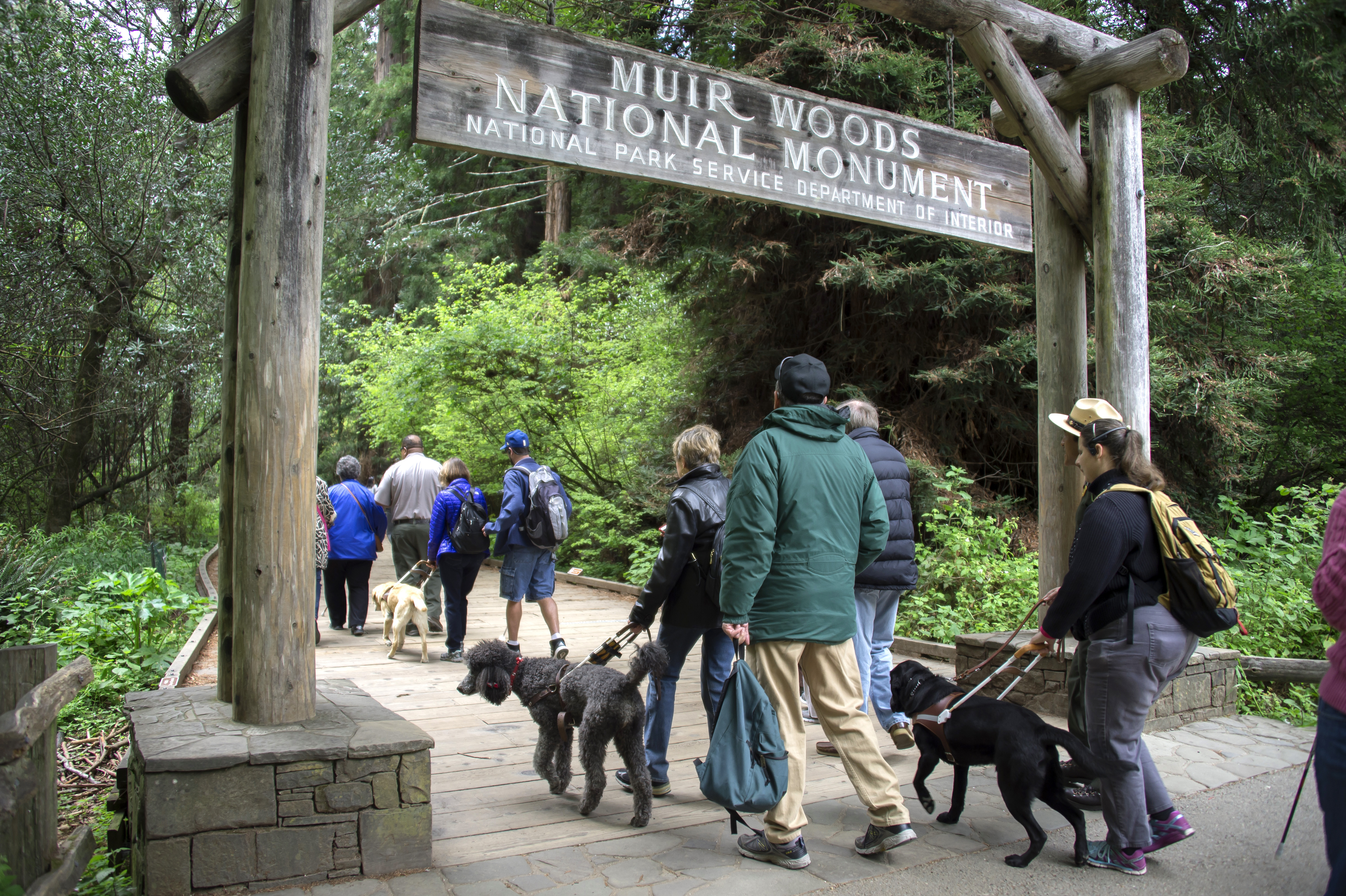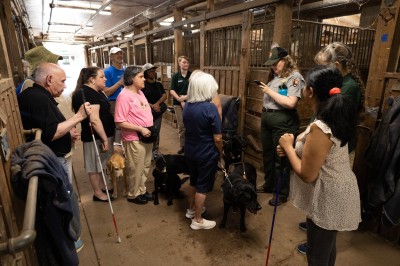
Testing Audio Description: Autumn Cook leading a tour of Rock Creek Park (2024)
DESCRIBING: A horizontal color photograph taken June 25, 2024
DESCRIPTION: Autumn Cook, a U.S. National Park Service Public Affairs Specialist at Rock Creek Park, reads an audio description to a crowd of about a dozen people, including visitors from the American Council of the Blind and NPS coworkers. The description is about the horse activities at the park, and this performance is a test of the description's in-place effectiveness in communicating critical information to people who are DeafBlind, blind or who have low-vision. This representative group of audience members — with several holding white canes and at least four guide dogs present — is inside a large wooden stable at Rock Creek Park.
Cook, who is a white woman, is wearing a traditional National Park Ranger uniform, with dark green pants and a khaki, short-sleeved and collared shirt, with the NPS logo on her left sleeve. She also is wearing a dark-green baseball hat, with the NPS logo on the front, and her wavy brown hair extends from beyond the hat down to her shoulders.
Cook is looking at her phone and reading the description while most of the people in the crowd face her and listen intently. The large wooden barn has at least a dozen horse stalls in this image, and the photograph gives the impression that there could be many more available in this building and elsewhere on the grounds.
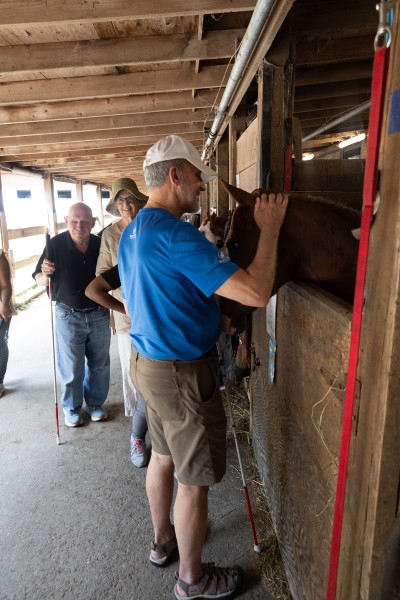
Testing Audio Description: Doug Powell and other ACB members in the horse barn (2024)
DESCRIBING: A vertical color photograph taken June 25, 2024
DESCRIPTION: American Council of the Blind member Doug Powell stands next to a wooden stable window and pets a horse who is sticking his head out of the opening in the plywood walls.
Powell is a man wearing a short-sleeved blue t-shirt, khaki knee-length shorts, and sandals. He has gray hair, but most of it is covered by a white baseball cap. He is using his right hand to pet the horse's head, with his left hand holding his white cane. Strands of hay are poking out of the stable's walls.
In the background, two other ACB members — Pat Sheehan and Francie Gilman — approach the horse as well. Sheehan is using his white cane in his right hand to navigate the space. Gilman is smiling, while waiting her turn with the horse.
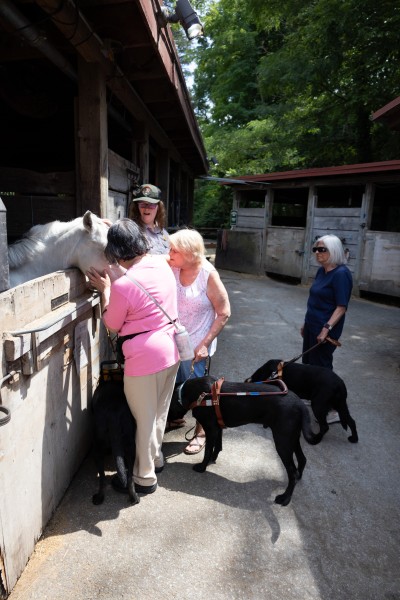
Testing Audio Description: ACB members at the horse barn (2024)
DESCRIBING: A vertical color photograph taken June 25, 2024
DESCRIPTION: Two American Council of the Blind members — from left to right, Jane Carona and Cindy LaBon — crowd around a stable window to pet a horse who is sticking his head out of an opening in the plywood wall. This barn window opens to the outdoors, and the sun is shining on the scene.
Autumn Cook, a U.S. National Park Service Public Affairs Specialist at this Rock Creek Park site, stands near the ACB members, wearing a NPS cap, and helping the visitors learn more about the horse and the horse-barn facilities on site.
Nearby, a third ACB member, Susan Crawford stands back and waits her turn to pet the horse. All three of the ACB members have black Labrador guide dogs at their sides. The horse is white.
In the background, there is a path to other barn facilities that makes an impression that the compound is much larger than just the area being shown.
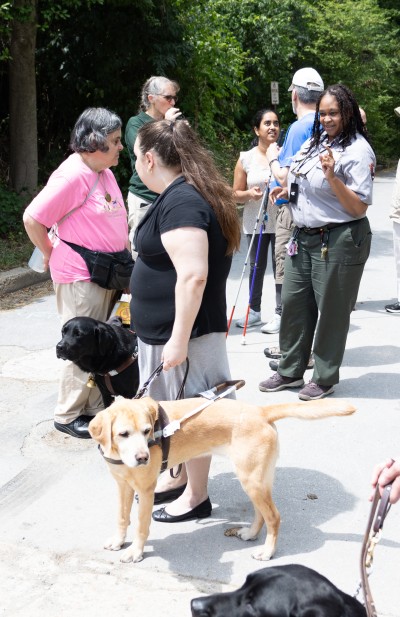
Testing Audio Description: Michelle Edwards leading a tour of Rock Creek Park (2024)
DESCRIBING: A vertical color photograph taken June 25, 2024
DESCRIPTION: Michelle Edwards, the Interpretation, Education & Community Engagement Programs Manager at Rock Creek Park, leads a tour of the park in this photo that shows a group of people with guide dogs. The group has gathered in an open outdoor area, and Edwards is talking with them about her plans for the group to explore the park.
Edwards is wearing a traditional National Park Ranger uniform, with dark green pants and a khaki, short-sleeved and collared shirt, with the NPS logo on her left sleeve. She is smiling and gesturing with her hands as she talks. Edwards is an African-American woman with shoulder-length black hair, woven tightly into braids.
Besides Edwards, five other people are visible, and parts of additional people and guide dogs have been cropped partially out of the photo, indicating that the group is larger than these half-dozen individuals. The group's members are socializing with each other or listening to Edwards and seem to be in an informal moment, between activities.
Besides the three guide dogs in the photo, two of the people photographed are holding white canes. Two of the three guide dogs are black Labradors, and one is a golden. All three dogs wear leather harnesses with a prominent handle on the back, indicating that they are working guide dogs.
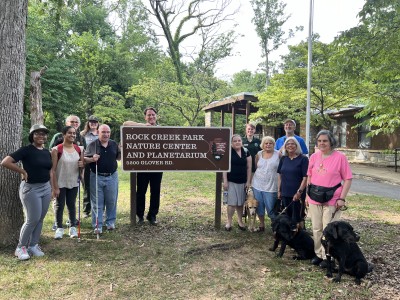
Testing Audio Description: Rock Creek focus group (2024)
DESCRIBING: A horizontal color photograph taken June 25, 2024
DESCRIPTION: A group photo of a dozen of the participants in a UniDescription field-research test at Rock Creek Park, standing around a large brown and metal sign that reads "Rock Creek Park Nature Center and Planetarium, 5200 Glover RD." In the background of this scene, there is a wooded area, filled with trees and a large building that serves as a visitor center.
Directly behind this metal sign is Dr. Brett Oppegaard, the principal investigator of the UniDescription project and a professor from the University of Hawaii. He is a 53-year-old white man with short brown hair. His head can be seen above the sign, and his legs, in black pants and with black shoes can be seen below the sign. He facilitated the discussions during the event.
Behind him, and to his right, are two NPS staff members who also were involved in organizing the field trip: Autumn Cook, a U.S. National Park Service Public Affairs Specialist at Rock Creek Park, and Tera Lynn Gray, an Accessibility Specialist at the Harpers Ferry Interpretive Design Center.
American Council of the Blind members pictured are: Swatha Nandhakumar, ACB's Advocacy and Outreach Specialist, Claire Stanley, ACB's Director of Advocacy and Governmental Affairs, and members Pat Sheehan, Cindy LaBon, Susan Crawford, Doug Powell, and Jane Carona, along with three guide dogs. In the photo as well are NPS interns Cameron Waiters and Jordan Land, who helped with the on-site logistics of the event.
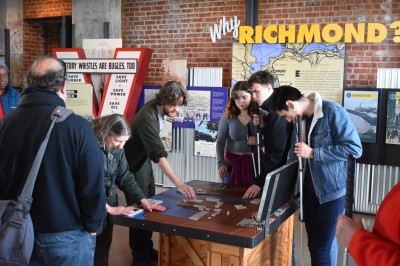
Testing Audio Description: Tactile maps and Audio Description at Rosie the Riveter (2024)
Ranger Zachary Yurek explains the tactile map and its messages at Rosie the Riveter WWII Home Front National Historical Park in February 2024. This horizontal photo shows the inside of a visitors center at the park, with many large-scale visual displays — such as a large text asking the question, Why Richmond?" and another one reading "... Whistles are Bugles, too" — surrounding a table in the middle of the room that has a tactile map. At the map, about a half dozen research volunteers have gathered, with Ranger Zachary Yurek in the middle of the group, describing the map and touching the map's pieces as a way to demonstrate how it is used. Three of the research volunteers have white canes, indicating that they are blind or have low-vision, and another volunteer is touching the map and exploring its structures.
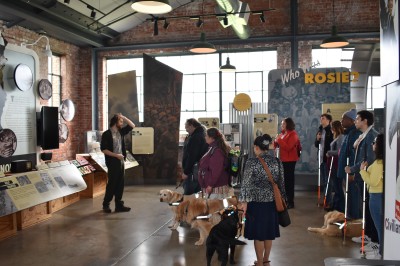
Testing Audio Description: Inside Rosie the Riveter National Historical Park (2024)
Ranger Zachary Yurek leads a discussion about Rosie the Riveter WWII Home Front National Historical Park in February 2024. In this horizontal photo, Yurek is standing in front of a large group of visual displays and exhibits in the visitors center with a group of about a dozen people in front of him. That group includes four guide dogs and several people holding white canes, indicating that they are people who are blind or who have low-vision. Yurek is wearing a traditional National Park Service uniform, with dark green pants, a gray shirt, and a dark-green sweater. He has medium-length brown hair, which he is brushing out of his face. He also has a full beard. The people in the group are dressed for cold weather. Many of them are wearing coats, and one has a stocking on his head.
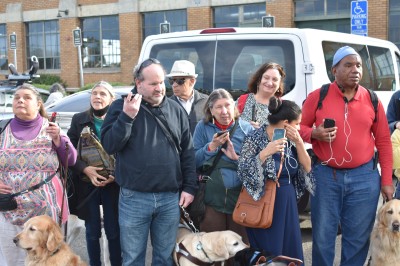
Testing Audio Description: Studying the use of the UniD app before entering the park (2024)
A group of volunteers who are blind or who have low-vision gather outside the Rosie the Riveter WWII Home Front National Historical Park in Richmond, CA, in February 2024. There are eight people in this photo and three guide dogs, but the image shows at least a couple of other people half-cropped out of the photo, indicating that there is a larger group. Everyone in the group is standing in what appears to be a parking lot, based on the cars in the background. They are all facing the camera, and six of the eight people are listening to the UniD app on their smartphones. It's a sunny day, but the people in the image are dressed for cold weather, with sweatshirts and coats.
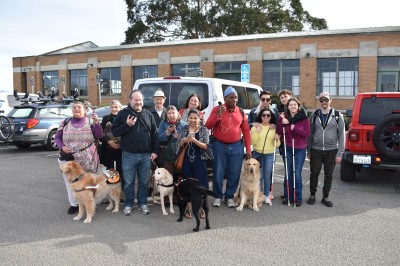
Testing Audio Description: A group photo of research participants at Rosie the Riveter NHP (2024)
A dozen volunteer research participants and UniD researcher Sajja Koirala took this horizontal group photo at Rosie the Riveter WWII Home Front National Historical Park in February 2024. In the photo, from left to right are: Debbie Armstrong, Susan Glass, David Hoffman, Victor Clifford, Bev Clifford, Alice Turner, Sajja Koirala, Anthony Lewis, Abby Moreno, Jayden Heilman, Anna Rolstad, Emerson Zorellsns, and Sean Dougherty. The people are all smiling and facing the camera. There are four guide dogs with this group, and several of the participants are holding white canes. They are standing in a parking lot, with cars behind them. Behind the cars is a single-story brick building that stretches beyond the frame of the image, looking like a school or warehouse in terms of its architecture. This brick building, part of the historical park, has enormous windows that bring light into the building from all sides.
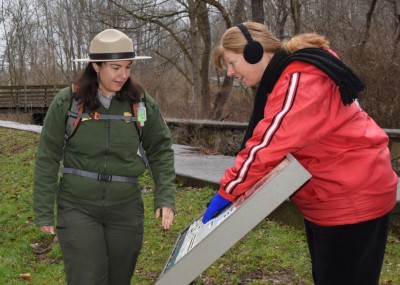
Testing Audio Description: Combining tactile maps and Audio Description proves to be an engaging combination at Cuyahoga Valley National Park in Ohio (2024)
Ranger Jennie Krob, left, introduces Akron Blind Center member Debbie Moss to a tactile map on an outdoor trail at Cuyahoga Valley National Park. In a moment captured by this horizontal image, Moss was learning about how Audio Description and tactile objects at the site are working together to make a more-accessible site. Moss is reaching over and feeling the features of the map, while experiencing the sensations of a cold winter day. She's wearing earmuffs and a thick and bright red winter jacket. Krob is wearing a rainproof version of the classic National Park Service uniform, mostly in dark greens, accented by a NPS straw hat with a flat rim.
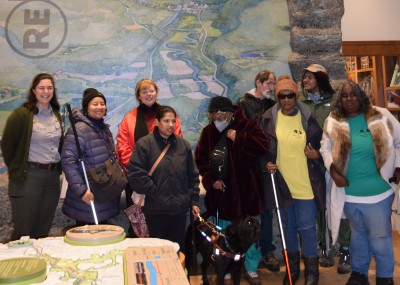
Testing Audio Description: Group photo of Akron Blind Center representatives visiting Cuyahoga Valley National Park in Ohio (2024)
This horizontal group photo shows the UniD field-research team, from the Akron Blind Center, standing in a row, against a large watercolor mural of the site, showing the site from a distant aerial perspective. From left to right, the image shows Ranger Jennie Krob, Renee Arrington-Johnson, Debbie Moss, UniD RA Sajja Koirala, Georgia Williamson, Jeff Seidel, Karen Grantham, Ranger Jesse (last name not provided), and Sandra Lee.
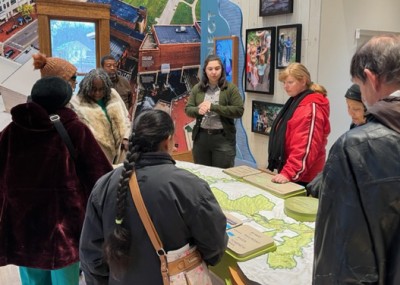
Testing Audio Description: Representatives of the Akron Blind Center visit Cuyahoga Valley National Park in Ohio and talk Audio Description (2024)
We made a return field visit in 2024 to Cuyahoga Valley National Park in Brecksville, Ohio, which is near both Cleveland and Akron. This group of about a half-dozen members of the Akron Blind Center, plus UniD Research Assistant Sajja Koirala, is shown in this horizontal image standing around a large table-sized map in the visitor center. Ranger Jennie Krob, facing the camera, is talking about the park's accessibility support systems, including the tactile map. The rest of the group is facing Krob and listening intently.
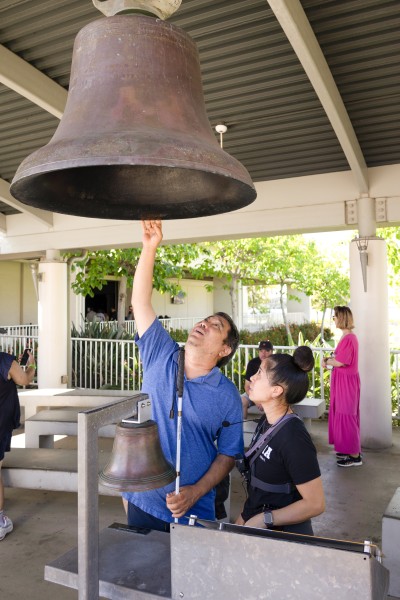
Testing Audio Description: Objects in space and in place are combined with experiments in Audio Description at Pearl Harbor National Memorial in Hawaii (2023)
A huge brass bell that was recovered from the USS Arizona after the attack on Pearl Harbor hangs in an outdoor gazebo at the national memorial. Research volunteer Anthony Akamine, left, stretches his right arm about as far as it can to touch the bell. There is a smaller recreation of the bell right below the big original, at about Akamineʻs stomach level, but he reached for the bigger bell after hearing Audio Description about it from UniD Research Assistant Haruka Hopper, right, and then wondering if he could reach up above his head and touch it. Akamine is holding his white cane in his left hand while reaching up with his right arm. Hopper is standing close to Akamine, on his left, looks up at the bell, too. Akamine is wearing a dark blue collared short-sleeved shirt. Hopper is wearing a black t-shirt, and her long hair is kept on the top of her hard in a tight bun.
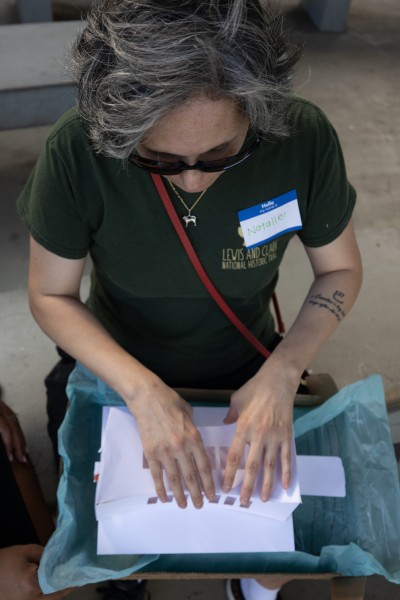
Testing Audio Description: Bringing together tactile objects and Audio Description at Pearl Harbor National Memorial in Hawaii (2023)
Hawaii Association of the Blind member Natalie Barrett was among the people with low-vision or blindness who helped The UniDescription Project in November 2023 test the efficacy of combining tactile learning objects, in this case a paper model of the USS Arizona Memorial, with Audio Description about the memorial. In this vertical image, looking down on Barrett from slightly above her, she is seated and touching the top of the memorial model, which is on her lap. The model has windows on its sides and its ceiling, like the real structure. Sheʻs also feeling the curves of the building, which is wider on the ends and narrower in the middle. Barrett is wearing a dark green Lewis and Clark National Historic Trail t-shirt and sunglasses. Her short hair is a mix of hues, black, gray, and white.
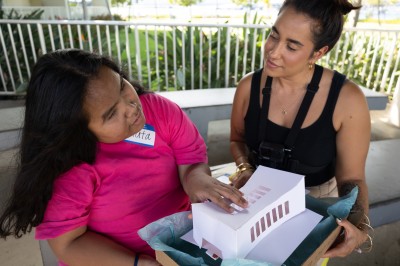
Testing Audio Description: Working together at Pearl Harbor National Memorial in Hawaii to better understand tactile objects with Audio Description (2023)
Volunteer participant Crata Mizutani, left, studies the shape of the USS Arizona Memorial building by touching a paper model of it provided by UniD researchers, including Research Assistant Kira Swearingen. Swearingen watches Mizutani examine the model while Mizutani, who is blind, provides think-aloud reactions to what sheʻs feeling and what sheʻs already learned that November 2023 day about the structure through Audio Description. This photograph, which has a horizontal orientation, shows Mizutani seated and leaning to her right while feeling the model in her lap with her left hand. Sheʻs wearing a bright pink t-shirt, and she has long, black hair. Swearingen, wearing a Go Pro camera around her neck to record Mizutaniʻs actions and observations, is seated next to Mizutani, on her left. Swearingen is looking carefully and kindly at Mizutani, studying her movements and listening to her comments. Swearingen is wearing a black tank top, and she has her long hair in a bun.
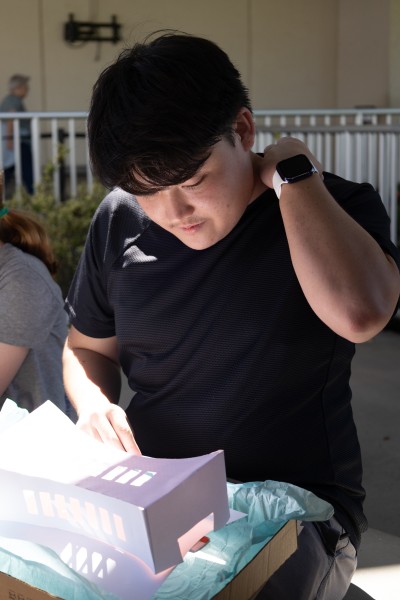
Testing Audio Description: Tactile models and Audio Description combined at Pearl Harbor National Memorial in Hawaii (2023)
University of Hawaii student Robbie Crouch, who has low-vision, worked with The UniDescription Project in November 2023 on research combining tactile objects and Audio Description. In this study, Crouch was asked to feel a paper model of the USS Arizona Memorial that replicated its distinctive features, such as its curving architecture, narrow in the middle and wider on the two ends, and its unique Tree of Life sculptural elements that created abstract forms out of irregular-shaped rectangles. In this vertical photograph, Crouch is sitting, with the model on his lap. Heʻs touching the model with his right hand and feeling its shape, while a beam of sunshine lights his hand and the model. The rest of his body is shaded. He is wearing a black t-shirt, and he has short black hair.
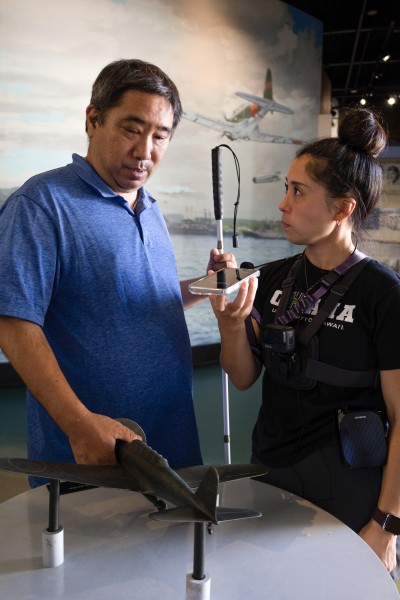
Testing Audio Description: At Pearl Harbor National Memorial in Hawaii, UniD studies combine environment, audio, and tactile displays (2023)
Inside a Pearl Harbor National Memorial exhibit space, from left to right, volunteer Anthony Akamine touches a tactile display of a World War II airplane bomber while UniD Research Assistant Haruka Hopper plays Audio Description about the bronze object. In the background, on a wall-sized illustration, the same type of Japanese airplane can be seen dropping a torpedo into Pearl Harbor. Hopper has a Go Pro camera strapped to her body, with the camera facing forward and capturing Akamineʻs reactions to the media heʻs being provided at this location. Hopper also holds her smartphone in her right hand, about chest level on Akamine, just a few inches away from him, so he clearly can hear the description. Akamine is holding his white cane in his left hand and is touching the model airplane with his right hand, looking down toward the model.
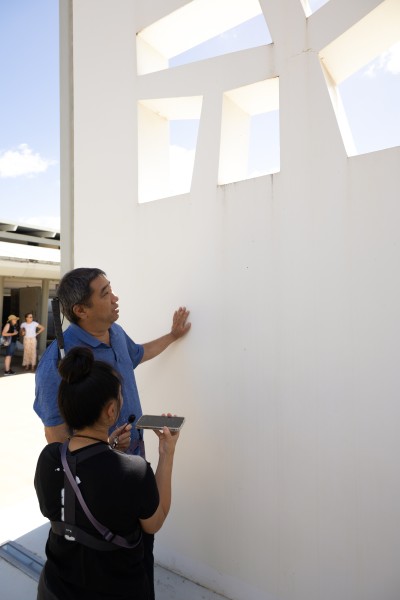
Testing Audio Description: A study of place, the physical environment, tactile objects, and Audio Description at Pearl Harbor National Memorial in Hawaii (2023)
Anthony Akamine, left, with his left hand touching the Tree of Life sculpture at Pearl Harbor National Memorial in Hawaii, listens to Audio Description from The UniDescription Project while navigating a complex setting that includes the audio, the touchable sculpture, and the historic place. The description is being played on a smartphone with an external speaker by UniD Research Assistant Haruka Hopper. Hopper is wearing black and has her back to the camera. Only part of the Tree of Life sculpture is included in this vertical photograph, showing a white stone wall and oddly shaped rectangles cut from the stone, creating windows through it but also a specific shape formed by the negative space. Akamine has his white cane in his right hand, tucked against his shoulder. Heʻs listening to the description and looking up toward the openings in the sculpture as a bright sunshine comes through the holes.
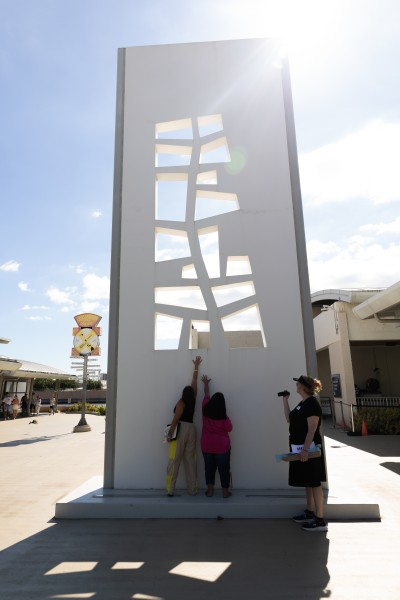
Testing Audio Description: Pearl Harbor National Memorial in Hawaii welcomed our group of volunteers who were blind or who had low-vision to study Audio Description on site (2023)
The Tree of Life sculpture at Pearl Harbor National Memorial is a massive monolithic piece. It is a rectangular slab of white stone, about 10 feet wide and 30 feet tall, with an abstract design cut out of the middle of it. The design features 16 irregular-shaped rectangles that in combination create the impression of a rising abstract figure. The sculpture was intended as a symbol of renewal, according to the park site, and was created by USS Arizona Memorial architect Alfred Preis. At the base of this sculpture, three UniD research collaborators are examining the sculpture and listening to Audio Description about it. Those collaborators, from left to right, are Research Assistant Kira Swearingen, volunteer participant Crata Mizutani, and the co-Principal Investigator on this stage of the study, Dr. Amy Parker from Portland State University. Swearingen and Mizutani are standing side-by-side facing the sculpture and reaching an arm up the piece to see how high they can touch. Swearingen, who is taller than Mizutani, also is able to reach higher on the sculpture. Parker is standing a few feet away, holding a video-recording camera, documenting the combined use of the sculpture and the description and observing the scene.
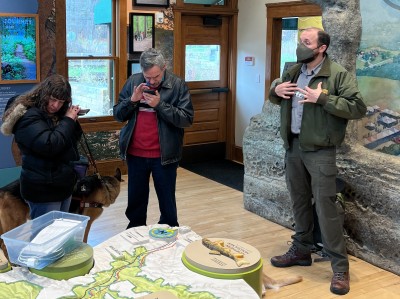
Testing Audio Description: Cuyahoga Valley National Park in Ohio welcomed our group of Cleveland Sight Center volunteers to study Audio Description on site (2023)
In November 2023, UniD Research Assistant Sajja Koirala led this group of Cleveland Sight Center volunteers through Cuyahoga Valley National Park in Ohio. The horizontal image shows, from left to right, volunteers Alice Zhender and Kenneth Hoeber, working with Ranger Joshua Angelini. Zhender, with her German Shepherd guide dog, and Hoeber are standing near a tabletop tactile map of the park. They are inside a visitor center with all sorts of displays around them. They are using the UniDescription mobile app to listen to Audio Description about the place. A few feet away, ranger Angelini is gesturing with his hands about the description and its relationship to the site. Angelini is wearing a dark green cloth face mask, common in Covid-era scenes. The face mask matches his waterproof jacket and pants; he's wearing a gray button-up shirt underneath the coat. Zhender and Hoeber also are wearing heavy winter coats.
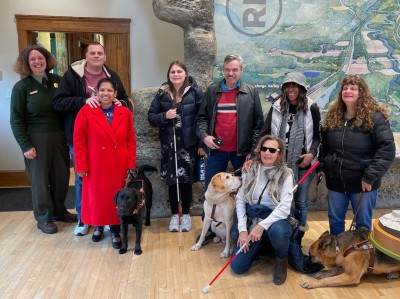
Testing Audio Description: Group photo of research-study participants at Cuyahoga Valley National Park in Ohio from the Cleveland Sight Center (2023)
This horizontal group photo shows, from left to right, ranger Arrye Rosser, Bill Self, UniD research assistant Sajja Koirala, her guide dog Laila, Gabriella Drago, Kenneth Hoeber, Sharon Williams, and Alice Zhender. Alicia Howerton is kneeling in front of the group, too. Besides, Laila, there are two other guide dogs in the image. Everyone is wearing some sort of winter coat, except ranger Rosser, who is dressed in her National Park Service uniform, which includes a dark green sweater and pants. In contrast, a gold badge and a gold name tag stand out on her dark sweater. Drago and Howerton are holding their white canes. The group is standing on a hardwood floor. Behind them is a partially obscured visitor center display that features a watercolor painting of the park site, shown from an aerial perspective, as if in a plane flying overhead.
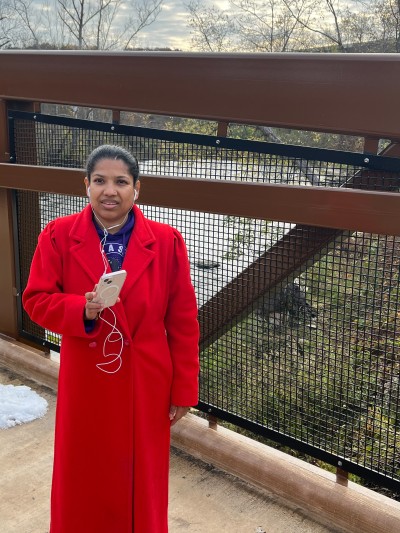
Testing Audio Description: Ph.D. researcher Sajja Koirala at Cuyahoga Valley National Park in Ohio (2023)
University of Hawai'i at Mānoa Ph.D. student Sajja Koirala tests Audio Description from The UniDescription Project at Cuyahoga Valley National Park in Ohio. Koirala, who lives in Ohio, has made Cuyahoga Valley a key place for her research into "Complete Trip" logistics. That means she is studying the planning activities needed for a person who is blind to successfully visit a national park. Koirala is blind and an active user of Audio Description in national parks. In this horizontal photo, she is shown wearing a long, red jacket. She is listening to audio from her smartphone via a set of wired headphones. She is standing on a bridge overlooking a waterway.
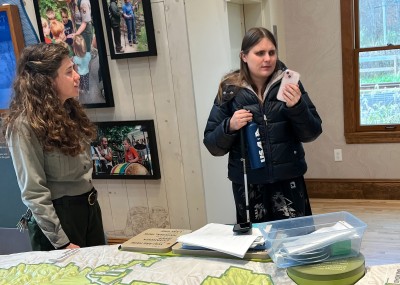
Testing Audio Description: UniD app use at Cuyahoga Valley National Park in Ohio with Cleveland Sight Center volunteer (2023)
Ranger Emily Garrison, left, works with Cleveland Sight Center volunteer Gabriella Drago to listen to Audio Description provided by The UniDescription Project at Cuyahoga Valley National Park in Ohio. Drago was part of a larger group of research participants working with UniD RA Sajja Koirala on her dissertation project in November 2023. In this horizontal image, Garrison is talking with Drago about what she's hearing on her smartphone, using the UniD app. Drago is holding the smartphone in front of her, with her left hand, and concentrating on the provided audio. In her right hand, she holds a white cane and a water bottle. She is wearing a heavy winter coat. Garrison is dressed in a park ranger uniform, with a khaki button-up shirt and dark green pants. Both Garrison and Drago have long brown hair. They are standing in a nondescript part of the visitor center, where enlarged photos of visitors using the park can be seen decorating the walls behind them, and a tabletop tactile map is in front of them.
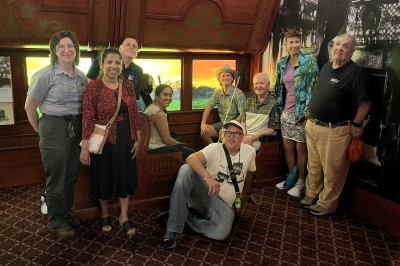
Testing Audio Description: Pullman National Historical Park in Chicago, IL, welcomed our group of American Council of the Blind volunteers to study Audio Description on site (2023)
In June 2023, UniD Research Assistant Sajja Koirala led this group of American Council of the Blind volunteers through Pullman National Historical Park as a way to test the efficacy of the Audio Description recently produced for the park during Descriptathon 9. The group is shown in front of a Pullman railcar exhibit, where some of the group is seated in the train benches, and others are standing next to it, including, from left to right, Park Ranger Linda Schwab, research assistant Koirala, Bill Self, Tabitha Kenlon, Swatha Nandhakumar, Michael Wiseman, Clark Rachel, ACB's executive director Dan Spoone, Leslie Spoone, and Jim Kral. Ranger Schwab is wearing her NPS uniform, including a gray collared shirt and dark green pants. The rest of the group is wearing casual summer clothes. Wiseman is sitting on the floor in front of the train benches, looking relaxed in a white T-shirt, jeans, and a white visor. He's also wearing black-rimmed glasses. Kenlon and Nandhakumar are sitting on one of the benches, and Rachfal and Dan Spoone are sitting on the other. Everyone in the group is smiling and looking at the photographer.
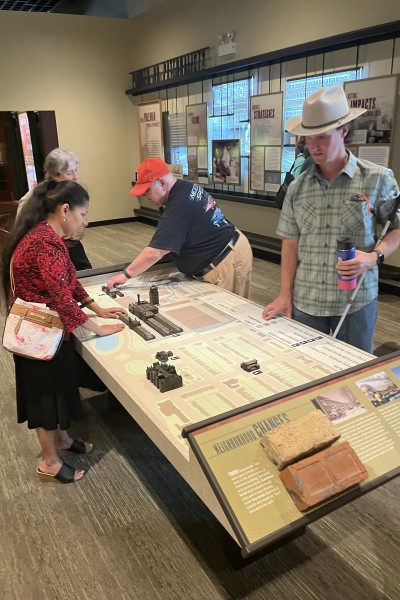
Testing Audio Description: This table of tactile models was put to the test by our American Council of the Blind volunteers studying the impacts of AD at Pullman NHP (2023)
Pullman National Historical Park in Chicago, IL, has a large table filled with Braille labels and tactile models that are being used by a UniD research team led by Research Assistant Sajja Koirala and, from left to right, park volunteer Elizabeth Mishler, and American Council of the Blind members Jim Kral and Clark Rachfal. This Koirala-led research study, in June 2023, tested, among other objectives, how Audio Description impacts the use and understanding of tactile models. The table is rectangular and a bit lower in height than a typical dinner table, but it also is larger, in the sense that it could probably comfortably seat three people on each side of it. The table has multiple tactile models of Pullman buildings as well as a significant amount of Braille text. The Braille text covers more than half of the table. Koirala is feeling one of the metal buildings, and Kral, on the other side of the table, is feeling a different one. He is leaning over the table and feeling it with his left hand. Rachfal, to Kral's left, is finger reading one of the sections of Braille.
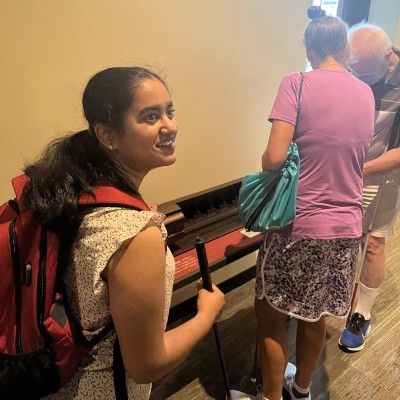
Testing Audio Description: American Council of the Blind members testing Audio Description with tactile models at Pullman National Historical Park in Chicago, IL (2023)
Swatha Nandhakumar and Leslie and Dan Spoone, left-right, learned about Chicago's Pullman National Historical Park through tactile exhibits and Audio Description during a UniD field study in June 2023.
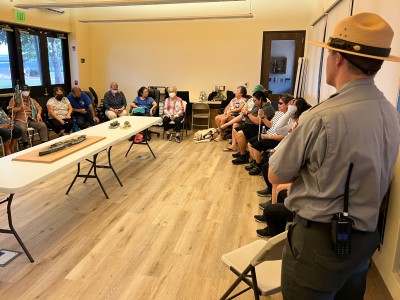
Testing Audio Description: David Kilton, Chief of Interpretation at Pearl Harbor National Memorial, welcomes research participants to a focus group discussion (2023)
David Kilton, Chief of Interpretation at Pearl Harbor National Memorial, is shown in the foreground, with his back to the camera, listening to a UniD focus group discussion about Audio Description at the National Park Service site. About 20 Hawaii Association of the Blind members are sitting in a U-shaped formation, facing Kilton, engaged in the discussion, although not all of them are included in this particular image. Kilton is dressed in a formal National Park Service uniform, including a tan and round-brimmed hat and khakis, with his buttoned-up shirt a slightly paler color than the dark-green pants heʻs wearing. A long rectangular table in the middle of the room, in the middle of the U-shape made by the chairs, displays three tactile models that are being discussed during this April 2023 session. Those are of a ship, a soda bottle, and a cooking pot. The HAB members are dressed in casual clothes, with some of them holding white canes and with one guide dog in the image, who is on the floor next to his companion.
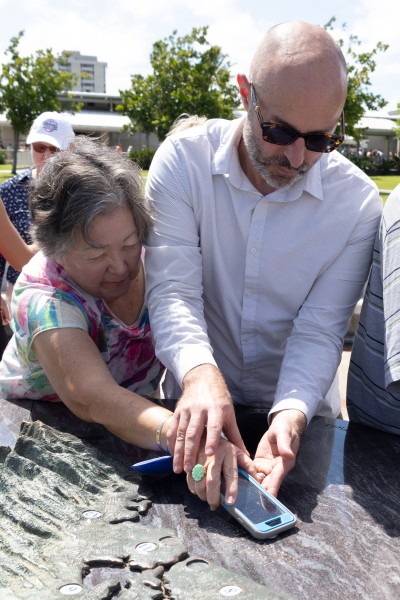
Testing Audio Description: Dr. Jordan Frith and a Hawaiian Association of the Blind research participant work with a NFC tag placed on an outdoor map at Pearl Harbor National Memorial (2023)
Working with a NFC tag on an outdoor tactile map at Pearl Harbor, Dr. Jordan Frith from Clemson University assists Hawaii Association of the Blind member Vickie Kennedy in finding the tag with her phone, so she can hear the Audio Description of the map. These tags were used in a research study conducted in Honolulu in April 2023. For this experiment, our team placed a quarter-sized NFC tag on this map that could be accessed and heard via smartphones using the UniD mobile app. To use the tag, the listener just had to open the app, find the tag on the map, and place the phone on the tag. In this image, Frith is wearing a white collared shirt and sunglasses, and he is helping HAB member Vickie Kennedy, who is blind, find the tag with her phone. Kennedy is stretching her right arm out, with the phone in it, and leaning over the table-top map, while Frith extends his arms as well and uses both of his hands to guide the placement of the phone and to help her position the phone's tag reader over the tag. Nondescript administration buildings at Pearl Harbor are in the background, in a park-like setting, lined with trees.
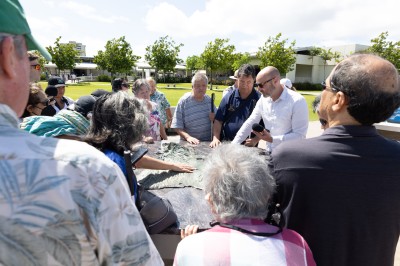
Testing Audio Description: Dr. Jordan Frith and research participants listening to our NFC tag placed on an outdoor map at Pearl Harbor National Memorial (2023)
Dr. Jordan Frith from Clemson University joined the UniD research team in Honolulu in April 2023 to help conduct field research at Pearl Harbor National Memorial. In this horizontal color photograph, Dr. Frith is slightly to the right of the center of the image, describing to a group of 15 research participants — as well as friends and family members serving as chaperones — how a Near-Field Communication Tag (NFC) works. For this experiment, our team placed a quarter-sized NFC tag on this map that could be accessed and heard via smartphones using the UniD mobile app. To use the tag, the listener just had to open the app, find the tag on the map, and place the phone on the tag. In this image, Dr. Frith is wearing a white collared shirt and sunglasses, and he is standing with the huge circular metal map about at his hip level. He is touching the map with his right hand and holding an audio-recording device in his left hand. Hawaii Association of the Blind members ring the table and are listening to the instruction, with more Pearl Harbor buildings and facilities, lined with trees, in the background.
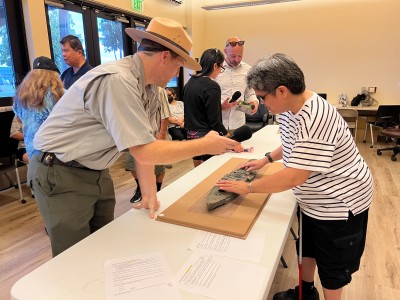
Testing Audio Description: David Kilton, Chief of Interpretation at Pearl Harbor National Memorial, shares a tactile model of the U.S.S. Arizona with research participants (2023)
David Kilton, Chief of Interpretation at Pearl Harbor National Memorial, holds an audio recorder in his right hand near the mouth of a female and blind research participant who is feeling a tactile model of the U.S.S. Arizona on a table in front of her. She is talking with Kilton about the experience. Kilton is dressed in a formal National Park Service uniform, including a tan and round-brimmed hat and khakis, with his buttoned-up shirt a slightly paler color than the dark-green pants heʻs wearing. The long rectangular table between them holds only this ship model, on a larger piece of background wood and a few pieces of paper. The model is made of resin. Itʻs dark green, too, and about three feet long. It shows the U.S.S. Arizona after it was destroyed in a World War II battle at Pearl Harbor, so the model is relatively flat on the top. In the background of this spacious classroom, other research participants try different tactile models or talk with each other. For example, further down the table, Dr. Jordan Frith of Clemson University is showing a different female research participant a tactile model of a soda bottle and explaining how the Near-Field Communication tag on it — white and about the size and shape of a quarter — works with the UniD app.
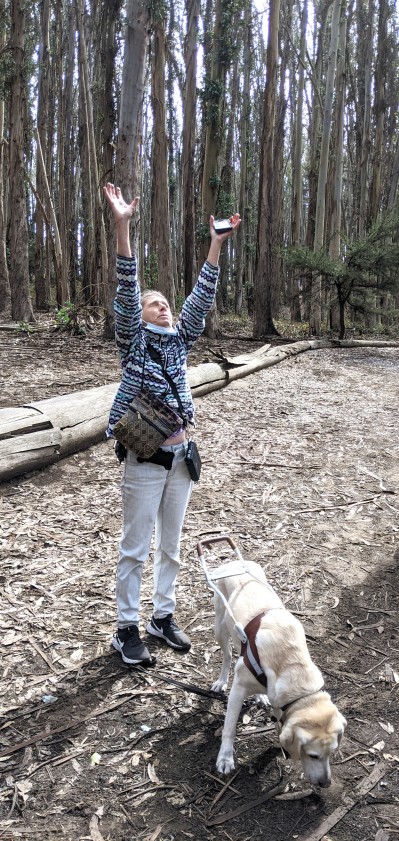
Testing Audio Description: American Council of the Blind member Susan Glass engages in an embodied audible moment in UniD's The Presidio: Goldsworthy Walk project, in San Francisco, CA (2021)
Susan Glass, an American Council of the Blind member, is raising her arms above her head and stretching out her hands in response to the audio prompt in UniD's The Presidio: Goldsworthy Walk project on her UniD app. She is holding her smartphone in one of her raised hands and closing her eyes to listen to the audio. She has a paper medical mask on – as a pandemic preventative in September of 2021. The mask has been pulled down under her chin for this moment. The audio prompt is asking her to imagine how tall the Spire artwork is, not shown here, by imaging her size, in the thick forest setting, and projecting herself in size up into the air several times. Glass is accompanied by her yellow lab guide dog, Omni, who is equipped with a handled harness. The dog – who actually has latte-foam-colored cream fur rather than yellow – is standing in front of Glass, sniffing the ground. Glass is a white, middle-aged woman, wearing a jacket and jeans, with a purse strapped around her shoulder. The jacket is monochrome, in all blues. But it also is decorative, with high-contrast horizonatal striping, ranging from light blues and aqua shades to dark blues. A line of logs creates a border on the ground behind her, separating the flat dirt path she is on from the dense forest. No foliage can be seen on most of the trees, which creates a background of vertical tree trunks. The trees are not large but plentiful. There is one small pine tree, about the height of a person, and a few leaves on the ground, but the forest is mostly a gray tone, created by the lack of color in the tree trunks.
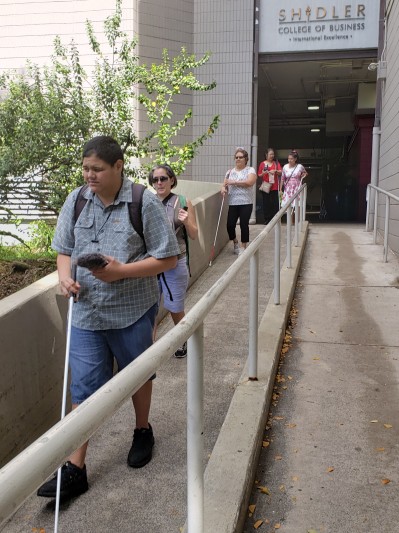
Testing Audio Description: University of Hawaii, Honolulu, HI (2019)
Imagine an audio-described college campus that supports full and independent use by people who are blind or visually impaired. Those just don't exist ... yet. The researchers who brought you The UniDescription Project – which is focused on improving media accessibility at U.S. National Park Service sites – are expanding their ideas onto their home campus, too, at the University of Hawaii at Manoa. Members of the Hawaii Association of the Blind, ACB's local chapter, have been working with the researchers to improve the descriptions. Those volunteers shown in this image include, from left to right, Jonah Sniffen, Natalie Barrett, Sharon Ige, Laureen Kukino, and Sajja Koirala. Another volunteer on this day, not pictured, was Vickie Kennedy. They are listening to campus description and walking down a ramp together out of UH's Shidler College of Business. The ramp is set up for two-traffic, with one side going up and into the building and the other going down and away from the building. This image shows the HAB/ACB group leaving the building after they had conducted various field tests inside the structure. They all are using canes to guide them, and they are holding audio records, to capture their thoughts as they navigate the area. Through this work, the researchers and HAB/ACB members hope to set a new standard for campus accessibility nationwide and also to build the tools and practices for others to freely follow those models, through open-source systems. So far, this research group, led by principal investigator Brett Oppegaard, has received two campus grants, totaling $5,000, to get the project started, and he and his students already have created more than 300 descriptions for the campus, with hundreds more to go. The descriptions are focused on specific places of interest on campus, such as buildings, and on describing routes between and among those buildings.
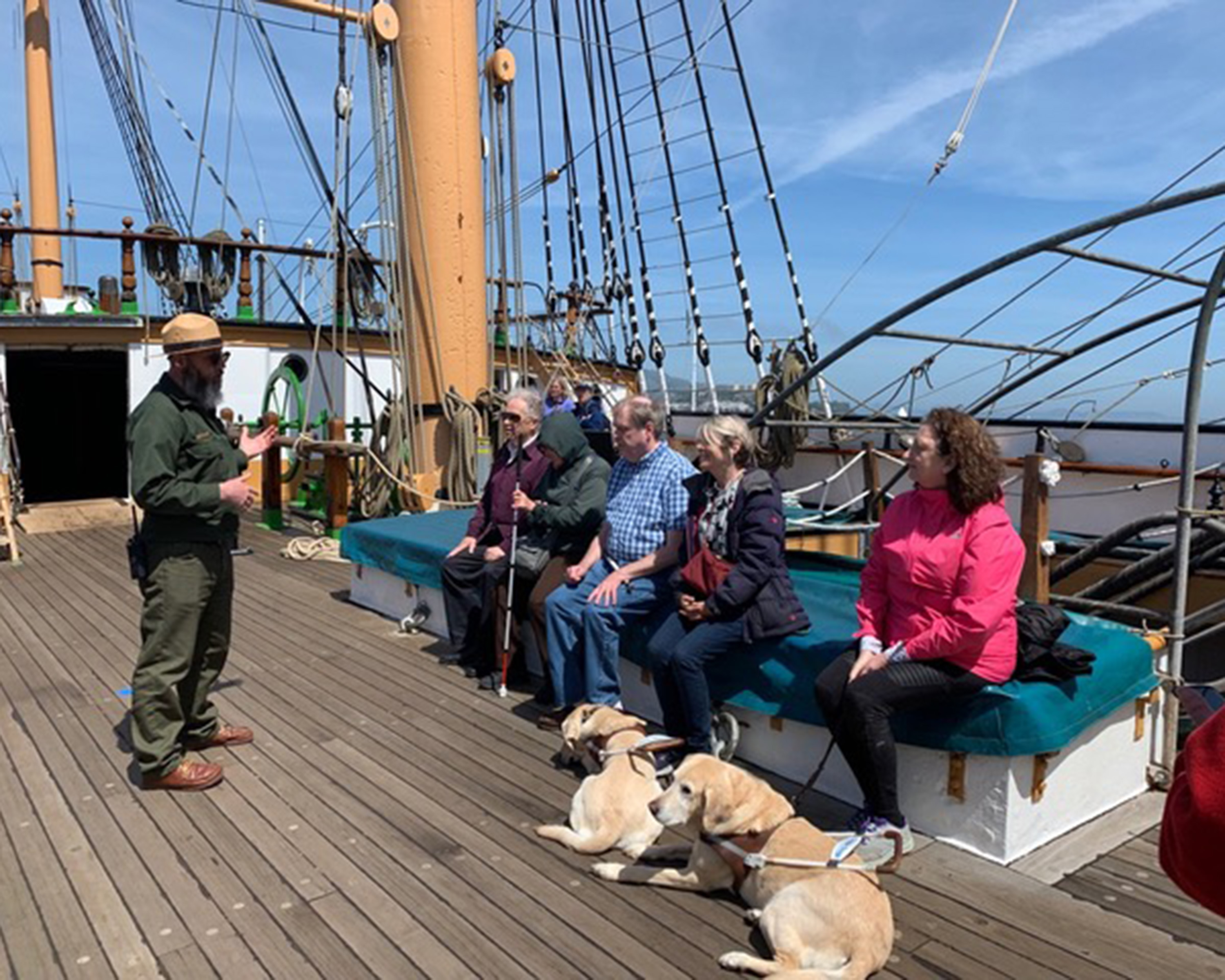
Testing Audio Description: San Francisco Maritime National Historical Park, California (2019)
Park Ranger J.R. Earnest described the San Francisco Maritime National Historical Park to American Council of the Blind members on the main deck of one of the site's historic vessels in 2019. This group was field testing the UniD mobile apps and Audio Description, and it included, from left to right, Victor Clifford, Beverly Clifford, John Glass, Susan Glass, and Alice McGrath Turner, and their guide dogs. The ACB members are sitting on a tarp-covered bench, roughly in the middle of the deck, facing ranger Earnest as he talks, with all sorts of ropes and rigging in the background.
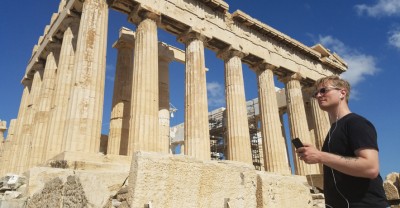
Testing Audio Description: Acropolis of Athens, Greece (2018)
The UniDescription Project's mantra is to 'audio describe the world,' and this image shows UniD developer Joe Oppegaard at the base of the Acropolis in Athens, Greece, testing the UniD system in May 2018. Joe is wearing a black shirt and dark sunglasses, contrasting with his blond hair and white earbuds, which are connected to his smartphone, as he listens to content on the phone underneath the massive marble columns at the remains of the Parthenon. The UniD Project team has worked with the University of Piraeus in Athens to audio describe parts of the Acropolis as well as various other major public attractions around the world, including more than 100 U.S. National Park Service sites.
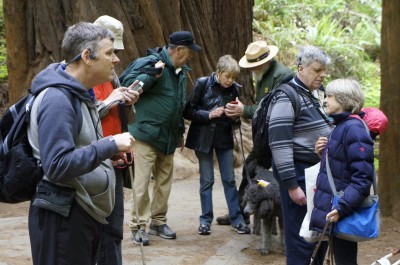
Testing Audio Description: Muir Woods National Monument, California (2018)
The Silicon Valley and San Francisco chapters of the American Council of the Blind participated in field tests of the UniD apps in April 2018 at Muir Woods National Monument. The seven people shown here – including Park Ranger Michael Faw, in the middle of the image – are either looking at, or listening to, their mobile devices in a setting of enormous redwood trees. These trees are so large, only the base of the trunks can be seen. And one in the background looks as long as an automobile. Ranger Faw is holding a red smartphone and showing it to McGuire, who is leaning in toward the screen and holding a leash attached to a dark-gray poodle. Blind or visually impaired members shown here include Frank Welte, Sally McGuire, Michael Keithley, and Susan Glass. Two people, though, because of the way they are obscured in the image, could not be identified.
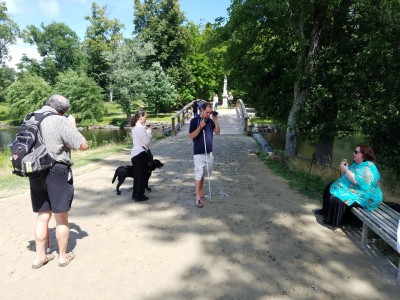
Testing Audio Description: Minute Man National Historical Park, Massachusetts (2018)
American Council of the Blind president Kim Charlson, right, was among the group of blind and visually impaired volunteers who field-tested the Minute Man National Historical Park's audio description of its site brochure on smartphone apps at the park in July 2018. Other volunteers testing the project this day were, from left to right: Bob Hachey, a former president of the Bay State Council of the Blind, and Beth White and Cory Kadlik of the Perkins School for the Blind. In this image, the group is listening to the description near the North Bridge, spanning the Concord River, where a key opening battle of the American Revolution took place, a moment Ralph Waldo Emerson memorialized in poetry as the "shot heard round the world." The four people mentioned in the caption are at one side of a small wooden bridge that raises to a slight crest over the Concord River. They all are listening to their smartphones in different ways, using earbuds, holding the phone up to their ear, or just holding the phone in a comfortable position in front of them, within earshot. In the background, on the other side of the bridge, is a stone obelisk, memorializing this place as the site of the battle. A few other visitors, plus a park ranger, are mingling in the area, talking on the bridge in the background.
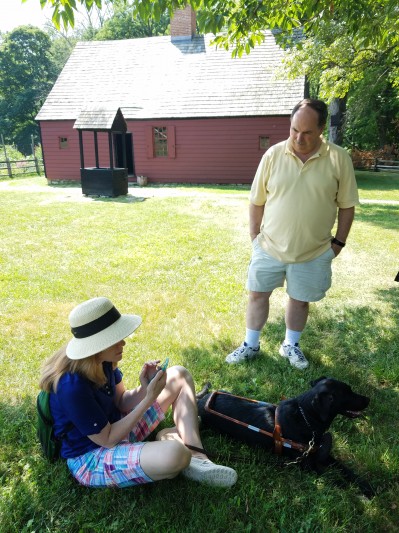
Testing Audio Description: Morristown National Historical Park, New Jersey (2018)
American Council of the Blind member Ginger Kutsch, left, sits with her black-labrador service dog in the shade of a tree near Wick House at the Morristown National Historical Park. She is listening to Audio Description about the historic structure in the background, where Gen. Arthur St. Clair made his headquarters during the American Revolutionary War. In July 2018, Park Ranger Eric Olsen, right, welcomed members of ACB to the park for this field test, including Christina Brino and Melissa Allman, as well as Associate Professor Brett Oppegaard, the principal investigator on the UniDescription project, from the University of Hawaii, as a part of the National Park Service-supported research project focused upon making media at public attractions more accessible.
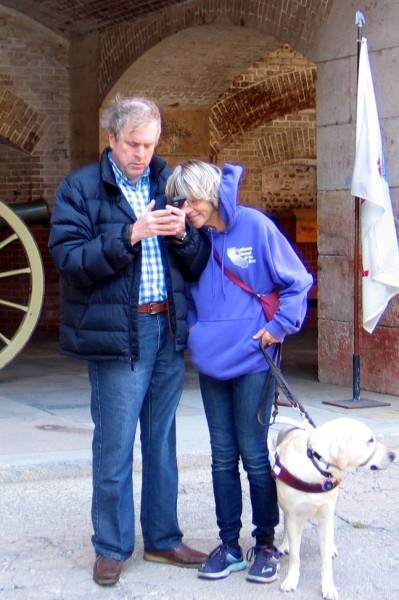
Testing Audio Description: Fort Point National Historic Site, California (2018)
John and Susan Glass, members of the Silicon Valley chapter of the American Council of the Blind, test UniD description at the Fort Point National Historic Site, which is on the southern side of the Golden Gate Bridge, at the entrance to San Francisco Bay. It's a cold and windy September day, and the Glasses are shown wearing warm clothes (John in a coat, and Susan in a heavy sweatshirt). Susan is holding the leash to her guide dog, a light-golden retriever, as John holds the phone, and they listen together to the description. In the background, a series of brick arches of the fort can be seen, indicating a labyrinth-like depth to the structure. Also in the background are the tip of a cannon, along with part of its large wooden wheels, and a white flag, with just a hint of an indistinguishable emblem on it.
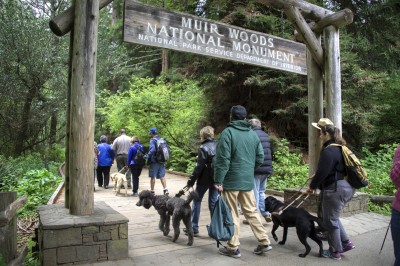
Testing Audio Description: Muir Woods National Monument, California (2018)
Members of the Silicon Valley and San Francisco chapters of the American Council of the Blind field tested the UniD app at Muir Woods National Monument in April 2018. This image shows about a dozen members of this group, with their backs to the camera, filing into the park. They are passing under a large wooden gateway, made of logs, adorned with a flat rectangular wooden sign, with carved lettering spelling out the words: "Muir Woods National Monument," "National Park Service," and "Department of the Interior." At least three guide dogs can be seen. The boardwalk path is surrounded by lush greenery.
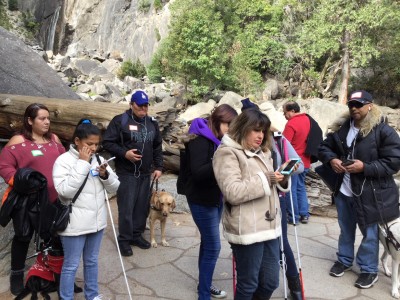
Testing Audio Description: Yosemite National Park, California (2017)
A group of low-vision and blind visitors are gathered at a viewpoint at Yosemite National Park. Three of them have guide dogs at their sides. Others have white canes. Most are shown listening to their mobile devices, testing new descriptions provided in The UniDescription Project's free mobile apps. Behind the people, at this viewpoint, are some large fallen logs that are touchable and within reach. In the gully, farther in the background, larger boulders and smaller rocks, nearly white to dark gray, form a dry river bed that leads to a majestic waterfall deep in the background. A few brushy trees and bushes emerge from the rock walls and stone-covered landscape, adding a bit of color to an otherwise gray setting. In terms of who is there, in the back row, from left to right, there is Veronica Hernandez, Joey Ruiz, Nikki Richards, and Chenier Derrick, and in the front row, Sajja Koirala (a University of Hawaii research assistant) and Martha Espitia. They all were among the more than two dozen low-vision or blind people (plus four guide dogs) who visited Yosemite National Park in November 2017 as a part of The UniDescription Project's field work. This Google-sponsored test (with a chartered bus provided by the American Council of the Blind) was a collaboration among the University of Hawaii-based research team and its partners, including the California Council of the Blind's Fresno chapter, the national American Council of the Blind organization, the National Park Service, and Google.
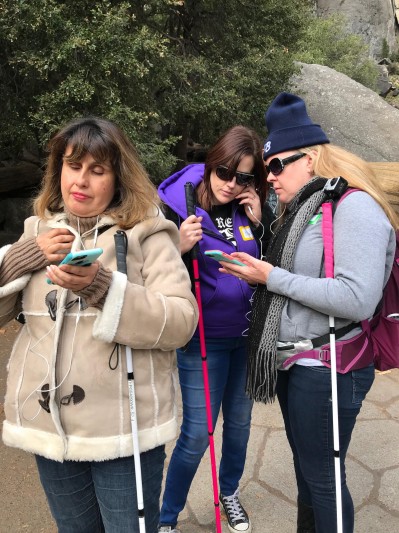
Testing Audio Description: Yosemite National Park, California (2017)
ACB members, from left to right, Martha Espitia, Nikki Richards, and Sarah Harris listening to UniD Audio Description at Yosemite National Park. Espitia holds her white cane against her body with her left arm, with her left hand holding her phone. She is listening to the description with white, wired Earpods. Richards and Harris, behind Espitia, are huddled close together, sharing a single set of Earpods, with each holding an Earpod to an ear with the hand not holding a cane. They all are wearing winter clothes.
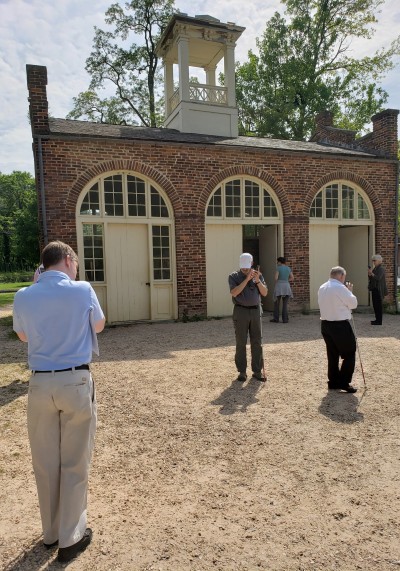
Testing Audio Description: Harpers Ferry National Historical Park (2017)
From left to right in the foreground, Eric Bridges, American Council of the Blind's Executive Director, Doug Powell, a member of ACB’s Rehabilitation Task Force, and Pat Sheehan, Director of the 508 Program Office at the U.S. Department of Veterans Affairs, use the UniD app to explore John Brown's Fort with U.S. National Park Service staff members at Harpers Ferry National Historical Park in West Virginia in 2017. In this image, the three ACB members are listening to their smartphones on the dirt patch outside of the fort. The fort – a one-room, single-story brick building – has three identical entry doors, each surrounded by an arch of window panes. Two of those doors are propped open for visitors to go in and out.
